ENR 1 GENERAL RULES AND PROCEDURES
ENR 1.1 General Rules
1 CIVIL
Note: Unless explicitly indicated, the rules in this section apply in both Belgium and Luxembourg.
1.1 Compliance with the Rules of the Air (SERA.2005)
The operation of an aircraft either in flight, on the movement area of an aerodrome or at an operating site shall be in compliance with the general rules as the applicable local provisions described in this section and, in addition, when in flight, either with:
1.2 Responsibilities (SERA.2010)
The pilot-in-command of an aircraft shall, whether manipulating the controls or not, be responsible for the operation of the aircraft in accordance with the rules of the air, except that the pilot-in-command may depart from these rules in circumstances that render such departure absolutely necessary in the interests of safety.
Before beginning a flight, the pilot-in-command of an aircraft shall become familiar with all available information appropriate to the intended operation. Pre-flight action for flights away from the vicinity of an aerodrome, and for all IFR flights, shall include a careful study of available current weather reports and forecasts, taking into consideration fuel requirements and an alternative course of action if the flight cannot be completed as planned.
1.3 Authority of Pilot-in-command of an Aircraft (SERA.2015)
The pilot-in-command of an aircraft shall have final authority as to the disposition of the aircraft while in command.
1.4 Problematic Use of Psychoactive Substances (SERA.2020)
No person whose function is critical to the safety of aviation (safety-sensitive personnel) shall undertake that function while under the influence of any psychoactive substance, by reason of which human performance is impaired. No such person shall engage in any kind of problematic use of substances.
1.5 Protection of Persons and Property
1.5.1 Negligent or Reckless Operation of Aircraft (SERA.3101)
An aircraft shall not be operated in a negligent or reckless manner so as to endanger life or property of others.
1.5.2 Minimum Heights (SERA.3105)
Except when necessary for take-off or landing, or by permission from the CAA, aircraft shall not be flown over the congested areas of cities, towns or settlements or over an open-air assembly of persons, unless at such a height as will permit, in the event of an emergency arising, a landing to be made without undue hazard to persons or property on the surface.
Note: In Belgium, except for helicopters, flights between 2200 and 0459 (2100 and 0359) should be performed at FL 050 or above whenever practicable.
1.5.3 Cruising Levels (SERA.3110)
The cruising levels at which a flight or a portion of a flight is to be conducted shall be in terms of:
- flight levels, for flights at or above the lowest usable flight level or, where applicable, above the transition altitude;
- altitudes, for flights below the lowest usable flight level or, where applicable, at or below the transition altitude.
1.5.4 Dropping or Spraying (SERA.3115)
1.5.4.1 General
1.5.4.1.1 In Belgium
Nothing shall be dropped or sprayed from an aircraft in flight except under the conditions prescribed by the CAA and as indicated by any relevant information, advice and/or clearance from the appropriate ATS unit.
1.5.4.1.2 In Luxembourg
Dropping or spraying from an aircraft in flight shall only be done during the day and in VMC and as indicated by any relevant information, advice and/or clearance from the appropriate ATS unit.
1.5.4.2 Fuel Dumping
Except in case of emergency, fuel dumping should be carried out over the North Sea at or above FL 100.
Other known traffic should be separated from the aircraft dumping fuel by at least 10 NM horizontally, but not behind the aircraft dumping fuel. If behind the aircraft dumping fuel within 15 MIN flying time or a distance of 50 NM, a vertical separation of at least 1 000 FT above or 3 000 FT below the aircraft dumping fuel should be maintained.
In case of emergency, fuel dumping shall, whenever possible, not be carried out:
- over the congested area of cities, towns or settlements;
- in holding patterns;
- less than 3 000 FT above other aircraft.
1.5.5 Towing (SERA.3120)
1.5.5.1 In Belgium
1.5.5.1.1 General
No aircraft or other object shall be towed by an aircraft except under the conditions prescribed by the CAA and as indicated by any relevant information, advice and/or clearance from the appropriate ATS unit.
1.5.5.1.2 Banner Towing
Banner towing flights are prohibited:
- below 1 400 FT AGL, except for taking up or throwing off the publicity banners;
- within a radius of 9 KM around EBOS ARP, except when authorized by Oostende ATC and under the conditions determined by the CAA;
- along the coast at a distance of less than 500 M seaside and less than 1 000 M landside from the shoreline, except for the area described in the item above;
- within a radius of 20 KM around EBBR ARP, except when authorized by the CAA.
Unless permitted otherwise by the CAA, banner towing flights are allowed only between 0900 and 1800 (0800 and 1700) from MON to SAT (HOL excl) and between 1300 and 1700 (1200 and 1600) on SUN and HOL.
The CAA can prohibit any banner towing flight conducted over an open-air assembly of persons.
A banner towing flight conducted over a built-up area of a city or town shall be limited to MAX 45 MIN. Over a single location the duration of a towing flight shall not exceed 15 MIN. These restrictions apply per day and per advertisement.
Formation banner towing flights shall be performed by maximum three aircraft.
Helicopters conducting banner towing flights shall maintain a speed of 40 KT MNM.
Banner towing aircraft shall be equipped with a transponder mode C.
1.5.5.2 In Luxembourg
Aircraft or other objects shall only be towed by an aircraft during the day and in VMC and as indicated by any relevant information, advice and/or clearance from the appropriate ATS unit.
1.5.6 Parachute Descents (SERA.3125)
Parachute descents, other than emergency descents, shall only be made after approval of the CAA and as indicated by any relevant information, advice and/or clearance from the appropriate ATS unit.
1.5.7 Aerobatic Flight (SERA.3130)
1.5.7.1 In Belgium
Aerobatic flights shall only be carried out in VMC, at a height of 2 000 FT AGL MNM (unless a lower level is permitted by the CAA) and as indicated by any relevant information, advice and/or clearance from the appropriate ATS unit.
No aerobatic flight shall be carried out over the congested areas of cities, towns or settlements, industrial buildings, the L.N.G. Terminal of Zeebrugge, nuclear plants or over an open-air assembly of persons, in controlled airspace or in restricted areas, except when authorized by the authority responsible for the area.
Aerobatic flight is prohibited in danger areas, unless they are created exclusively for this purpose.
1.5.7.2 In Luxembourg
Aerobatic flights shall only be carried out in designated airspaces during the day and in VMC and as indicated by any relevant information, advice and/or clearance from the appropriate ATS unit.
Pilots have to maintain visual contact with the ground at all times.
The express consent of all persons on board the aircraft is required for each manoeuvre.
1.5.8 Formation flights (SERA.3135)
1.5.8.1 In Belgium
Aircraft shall not be flown in formation except in VMC and by pre-arrangement among the pilots-in-command of the aircraft taking part in the flight and, for formation flight in controlled airspace, in accordance with the conditions prescribed by the appropriate ATS unit. These conditions will include the following:
- one of the pilots-in-command shall be designated as the flight leader;
- the formation operates as a single aircraft with regard to navigation and position reporting;
- separation between aircraft in the flight shall be the responsibility of the flight leader and the pilots-in-command of the other aircraft in the flight and shall include periods of transition when aircraft are manoeuvring to attain their own separation within the formation and during join-up and breakaway; and
- for State aircraft a maximum lateral, longitudinal and vertical distance between each aircraft and the flight leader in accordance with ICAO Standards (exception: military OAT formation flights which are described in § 2.3.2). For other than State aircraft a distance not exceeding 0.5 NM laterally and longitudinally and 100 FT vertically from the flight leader shall be maintained by each aircraft.
Formation landing or take-off are subject to permission from the CAA.
Aircraft carrying paying passengers shall not be flown in formation.
1.5.8.2 In Luxembourg
Aircraft shall not be flown in formation except under the following conditions:
- aircraft shall not be flown in formation except by pre-arrangement among the pilots-in-command of the aircraft taking part in the flight;
- take-off in formation at ELLX may only take place upon prior authorisation by the CAA after consultation with the Air Navigation Service Provider;
- if such formation flights take place in controlled airspace, the following conditions apply:
- one of the pilots-in-command shall be designated as the flight leader;
- the formation operates as a single aircraft with regard to navigation and position reporting;
- the formation uses one single transponder during the flight in formation, which shall be the one on board the flight leader’s aircraft;
- separation between aircraft in the flight shall be the responsibility of the flight leader and the pilots-in-command of the other aircraft in the flight and shall include periods of transition when aircraft are manoeuvring to attain their own separation within the formation and during join-up and breakaway; and
- a distance not exceeding 0.5 NM laterally and longitudinally and 100 FT vertically from the flight leader shall be maintained by each aircraft.
1.5.9 Unmanned Free Balloons (SERA.3140)
1.5.9.1 Classification of Unmanned Free Balloons
Unmanned free balloons shall be classified as:
- light: an unmanned free balloon which carries a payload of one or more packages with a combined mass of less than 4 KG, unless qualifying as a heavy balloon in accordance with (c)(2),(3) or (4)
- medium: an unmanned free balloon which carries a payload of two or more packages with a combined mass of 4 KG or more, but less than 6 KG, unless qualifying as a heavy balloon in accordance with (c)(2), (3) or (4)
- heavy: an unmanned free balloon which carries a payload which:
- has a combined mass of 6 KG or more; or
- includes a package of 3 KG or more; or
- includes a package of 2 KG or more with an area density of more than 13 G/CM², determined by dividing the total mass in grams of the payload package by the area in square centimetres of its smallest surface; or
- uses a rope or other device for suspension of the payload that requires an impact force of 230 N or more to separate the suspended payload from the balloon.
1.5.9.2 General Operating Rules
An unmanned free balloon shall not be operated without authorisation from the State from which the launch is made.
An unmanned free balloon, other than a light balloon used exclusively for meteorological purposes and operated in the manner prescribed by the CAA, shall not be operated across the territory of another State without authorisation from the other State concerned. This authorisation shall be obtained prior to the launching of the balloon if there is reasonable expectation, when planning the operation, that the balloon may drift into airspace over the territory of another State. Such authorisation may be obtained for a series of balloon flights or for a particular type of recurring flight, e.g. atmospheric research balloon flights.
An unmanned free balloon shall be operated in accordance with conditions specified by the State of Registry and the State(s) expected to be overflown.
An unmanned free balloon shall not be operated in such a manner that impact of the balloon, or any part thereof, including its payload, with the surface of the earth, creates a hazard to persons or property.
A heavy unmanned free balloon shall not be operated over the high seas without prior coordination with the responsible ATS authority.
1.5.9.3 Operating Limitations and Equipment Requirements
A heavy unmanned free balloon shall not be operated without authorisation from the responsible ATS authority at or through any level below FL 600 at which:
- there are clouds or obscuring phenomena of more than four oktas coverage; or
- the horizontal visibility is less than 8 KM.
A heavy or medium unmanned free balloon shall not be released in a manner that will cause it to fly lower than 1 000 FT over the congested areas of cities, towns or settlements or an open-air assembly of persons not associated with the operation.
A heavy unmanned free balloon shall not be operated unless:
- it is equipped with at least two payload flight-termination devices or systems, whether automatic or operated by telecommand, that operate independently of each other;
- for polyethylene zero-pressure balloons, at least two methods, systems, devices, or combinations thereof, that function independently of each other are employed for terminating the flight of the balloon envelope;
- the balloon envelope is equipped with either a radar reflective device(s) or radar reflective material that will present an echo to surface radar operating in the 200 MHZ to 2 700 MHZ frequency range, and/or the balloon is equipped with such other devices as will permit continuous tracking by the operator beyond the range of ground-based radar.
A heavy unmanned free balloon shall not be operated under the following conditions:
- in an area where ground-based SSR equipment is in use, unless it is equipped with a secondary surveillance radar transponder, with pressure-altitude reporting capability, which is continuously operating on an assigned code, or which can be turned on when necessary by the tracking station;
- in an area where ground-based ADS-B equipment is in use, unless it is equipped with an ADS-B transmitter, with pressure-altitude reporting capability, which is continuously operating or which can be turned on when necessary by the tracking station.
An unmanned free balloon that is equipped with a trailing antenna that requires a force of more than 230 N to break it at any point shall not be operated unless the antenna has coloured pennants or streamers that are attached at not more than 15 M intervals.
A heavy unmanned free balloon shall not be operated below FL 600 at night or during any other period prescribed by the CAA, unless the balloon and its attachments and payload, whether or not they become separated during the operation, are lighted.A heavy unmanned free balloon that is equipped with a suspension device (other than a highly conspicuously coloured open parachute) more than 15 M long shall not be operated during night below FL 600 unless the suspension device is coloured in alternate bands of high conspicuity colours or has coloured pennants attached.
1.5.9.4 Termination
The operator of a heavy unmanned free balloon shall activate the appropriate termination devices required by the operating limitations:
- when it becomes known that weather conditions are less than those prescribed for the operation;
- if a malfunction or any other reason makes further operation hazardous to air traffic or to persons or property on the surface;
- prior to unauthorised entry into the airspace over another State’s territory.
1.5.9.5 Flight Notification
1.5.9.5.1 Pre-flight notification
Early notification of the intended flight of an unmanned free balloon in the medium or heavy category shall be made to the appropriate air traffic services unit not less than seven days before the date of the intended flight.
Notification of the intended flight shall include such of the following information as may be required by the appropriate air traffic services unit:
- balloon flight identification or project code name;
- balloon classification and description;
- SSR code, aircraft address or NDB frequency as applicable;
- operator’s name and telephone number;
- launch site;
- estimated time of launch (or time of commencement and completion of multiple launches);
- number of balloons to be launched and the scheduled interval between launches (if multiple launches);
- expected direction of ascent;
- cruising level(s) (pressure-altitude);
- the estimated elapsed time to pass FL 600 or to reach cruising level if at or below FL 600, together with the estimated location. If the operation consists of continuous launchings, the time to be included shall be the estimated time at which the first and the last in the series will reach the appropriate level (e.g. 122136Z–130330Z);
- the estimated date and time of termination of the flight and the planned location of the impact/recovery area. In the case of balloons carrying out flights of long duration, as a result of which the date and time of termination of the flight and the location of impact cannot be forecast with accuracy, the term ‘long duration’ shall be used. If there is to be more than one location of impact/recovery, each location shall be listed together with the appropriate estimated time of impact. If there is to be a series of continuous impacts, the time to be included shall be the estimated time of the first and the last in the series (e.g. 070330Z–072300Z).
Any changes in the pre-launch information shall be forwarded to the ATS unit concerned not less than 6 HR before the estimated time of launch, or in the case of solar or cosmic disturbance investigations involving a critical time element, not less than 30 MIN before the estimated time of the commencement of the operation.
1.5.9.5.2 Notification of launch
Immediately after a medium or heavy unmanned free balloon is launched the operator shall notify the appropriate air traffic services unit of the following:
- balloon flight identification;
- launch site;
- actual time of launch;
- estimated time at which FL 600 pressure-altitude will be passed, or the estimated time at which the cruising level will be reached if at or below FL 600, and the estimated location;
- any changes to the information previously notified in accordance with items (g) an (h) of § 1.5.9.5.1 above.
1.5.9.5.3 Notification of cancellation
The operator shall notify the appropriate ATS unit immediately it is known that the intended flight of a medium or heavy unmanned free balloon, previously notified in accordance with § 1.5.9.5.1, has been cancelled.
1.5.9.6 Position Recording and Reports
The operator of a heavy unmanned free balloon operating at or below FL 600 shall monitor the flight path of the balloon and forward reports of the balloon’s position as requested by ATS. Unless air traffic services require reports of the balloon’s position at more frequent intervals, the operator shall record the position every 2 HR.
The operator of a heavy unmanned free balloon operating above FL 600 shall monitor the flight progress of the balloon and forward reports of the balloon’s position as requested by ATS. Unless air traffic services require reports of the balloon’s position at more frequent intervals, the operator shall record the position every 24HR.
If a position cannot be recorded, the operator shall immediately notify the appropriate ATS unit. This notification shall include the last recorded position. The appropriate air traffic services unit shall be notified immediately when tracking of the balloon is re-established.
One hour before the beginning of planned descent of a heavy unmanned free balloon, the operator shall forward to the appropriate ATS unit the following information regarding the balloon:
- the current geographical position
- the current level (FL)
- the forecast time of penetration of FL 600, if applicable
- the forecast time and location of ground impact
The operator of a heavy or medium unmanned free balloon shall notify the appropriate ATS unit when the operation is ended.
1.5.10 Prohibited Areas and Restricted Areas (SERA.3145)
Aircraft shall not be flown in a prohibited area or in a restricted area, the particulars of which have been duly published, except in accordance with the conditions of the restrictions or by permission of the State over whose territory the areas are established.
1.6 Avoidance of Collisions
1.6.1 General (SERA.3201)
Nothing in these rules shall relieve the pilot-in-command of an aircraft from the responsibility of taking such action, including collision avoidance manoeuvres based on resolution advisories provided by ACAS equipment, as will best avert collision.
1.6.2 Proximity (SERA.3205)
An aircraft shall not be operated in such proximity to other aircraft as to create a collision hazard.
1.6.3 Right-of-way (SERA.3210)
The aircraft that has the right-of-way shall maintain its heading and speed.
An aircraft that is aware that the manoeuvrability of another aircraft is impaired shall give way to that aircraft.
An aircraft that is obliged by the following rules to keep out of the way of another shall avoid passing over, under or in front of the other, unless it passes well clear and takes into account the effect of aircraft wake turbulence.
1.6.3.1 Approaching Head-on
When two aircraft are approaching head-on or approximately so and there is danger of collision, each shall alter its heading to the right.
1.6.3.2 Converging
When two aircraft are converging at approximately the same level, the aircraft that has the other on its right shall give way, except as follows:
- power-driven heavier-than-air aircraft shall give way to airships, gliders and balloons;
- airships shall give way to gliders and balloons;
- gliders shall give way to balloons;
- power-driven aircraft shall give way to aircraft which are seen to be towing other aircraft or objects;
- RPA shall give way to all manned aircraft.
1.6.3.3 Overtaking
An overtaking aircraft is an aircraft that approaches another from the rear on a line forming an angle of less than 70 degrees with the plane of symmetry of the latter, i.e. is in such a position with reference to the other aircraft that at night it should be unable to see either of the aircraft's left (port) or right (starboard) navigation lights.
An aircraft that is being overtaken has the right-of-way and the overtaking aircraft, whether climbing, descending or in horizontal flight, shall keep out of the way of the other aircraft by altering its heading to the right, and no subsequent change in the relative positions of the two aircraft shall absolve the overtaking aircraft from this obligation until it is entirely past and clear.
Note: A sailplane overtaking another sailplane may alter its course to the right or to the left.
1.6.3.4 Landing
An aircraft in flight, or operating on the ground or water, shall give way to aircraft landing or in the final stages of an approach to land.
When two or more heavier-than-air aircraft are approaching an aerodrome for the purpose of landing, aircraft at the higher level shall give way to aircraft at the lower level, but the latter shall not take advantage of this rule to cut in front of another which is in the final stages of an approach to land, or to overtake that aircraft. Nevertheless, power-driven heavier-than-air aircraft shall give way to sailplanes.
An aircraft that is aware that another is compelled to land (emergency landing) shall give way to that aircraft.
1.6.3.5 Taking Off
An aircraft taxiing on the manoeuvring area of an aerodrome shall give way to aircraft taking off or about to take off.
1.6.3.6 Surface Movement of Aircraft
In case of danger of collision between two aircraft taxiing on the movement area of an aerodrome or equivalent part of an operating site, the following shall apply:
- when two aircraft are approaching head on, or approximately so, each shall stop or where practicable alter its course to the right so as to keep well clear
- when two aircraft are on a converging course, the one which has the other on its right shall give way
- an aircraft which is being overtaken by another aircraft shall have the right-of-way and the overtaking aircraft shall keep well clear of the other aircraft
At a controlled aerodrome an aircraft taxiing on the manoeuvring area shall stop and hold at all runway-holding positions unless an explicit clearance to enter or cross the runway has been issued by the aerodrome control tower. An aircraft taxiing on the manoeuvring area shall stop and hold at all lighted stop bars and may proceed further when the lights are switched off.
1.6.4 Lights to be Displayed by Aircraft (SERA.3215)
- Except as provided by (e), at night all aircraft in flight shall display:
- anti-collision lights intended to attract attention to the aircraft; and
- except for balloons, navigation lights intended to indicate the relative path of the aircraft to an observer and other lights shall not be displayed if they are likely to be mistaken for these lights.
- Except as provided by (e), at night:
- all aircraft moving on the movement area of an aerodrome shall display navigation lights intended to indicate the relative path of the aircraft to an observer and other lights shall not be displayed if they are likely to be mistaken for these lights;
- unless stationary and otherwise adequately illuminated, all aircraft on the movement area of an aerodrome shall display lights intended to indicate the extremities of their structure, as far as practicable;
- all aircraft taxiing or being towed on the movement area of an aerodrome shall display lights intended to attract attention to the aircraft;
- all aircraft on the movement area of an aerodrome whose engines are running shall display lights which indicate that fact.
- Except as provided by (e), all aircraft in flight and fitted with anti-collision lights to meet the requirement of (a)(1) shall display such lights also during day.
- Except as provided by (e), all aircraft:
- taxiing or being towed on the movement area of an aerodrome and fitted with anti-collision lights, to meet the requirement of (b)(3); or
- on the movement area of an aerodrome and fitted with lights to meet the requirement of (b)(4), shall display such lights also during day.
- A pilot shall be permitted to switch off or reduce the intensity of any flashing lights fitted to meet the requirement of (a), (b), (c) and (d) if they do or are likely to:
- adversely affect the satisfactory performance of duties;
- subject an outside observer to harmful dazzle.
1.6.5 Simulated Instrument Flights (SERA.3220)
An aircraft shall not be flown under simulated instrument flight conditions unless fully functioning dual controls are installed in the aircraft and an additional qualified pilot occupies a control seat to act as safety pilot for the person who is flying under simulated instrument conditions. The safety pilot shall have adequate vision forward and to each side of the aircraft, or a competent observer in communication with the safety pilot shall occupy a position in the aircraft from which the observer’s field of vision adequately supplements that of the safety pilot.
1.6.6 Operation on and in the Vicinity of Aerodromes (SERA.3225)
An aircraft operated on or in the vicinity of an aerodrome shall:
- observe other aerodrome traffic for the purpose of avoiding collision;
- conform with or avoid the pattern of traffic formed by other aircraft in operation;
- except for balloons, make all turns to the left, when approaching for a landing and after taking off, unless otherwise indicated, or instructed by ATC;
- except for balloons, land and take off into the wind unless safety, the runway configuration, or air traffic considerations determine that a different direction is preferable.
1.6.7 Water operations (SERA.3230)
1.6.7.1 General
When two aircraft or an aircraft and a vessel are approaching one another and there is a risk of collision, the aircraft shall proceed with careful regard to existing circumstances and conditions including the limitations of the respective craft.
1.6.7.1.1 Converging
An aircraft which has another aircraft or a vessel on its right shall give way so as to keep well clear.
1.6.7.1.2 Approaching head-on
An aircraft approaching another aircraft or a vessel head-on, or approximately so, shall alter its heading to the right to keep well clear.
1.6.7.1.3 Overtaking
The aircraft or vessel which is being overtaken has the right of way, and the one overtaking shall alter its heading to keep well clear.
1.6.7.1.4 Landing and taking off
Aircraft landing on or taking off from the water shall, in so far as practicable, keep well clear of all vessels and avoid impeding their navigation.
1.6.7.2 Lights to be Displayed by Aircraft on the Water
At night or during any other period prescribed by the CAA, all aircraft on the water shall display lights as required by the Convention on the International Regulations for Preventing Collisions at Sea (1972), unless it is impractical for them to do so, in which case they shall display lights as closely similar as possible in characteristics and position to those required by the International Regulations.
1.7 SIGNALS (SERA.3301)
Upon observing or receiving any of the signals indicated below, aircraft shall take such action as may be required by the indicated interpretation of the signal.
1.7.1 Distress and Urgency Signals
1.7.1.1 General
Notwithstanding the provisions in § 1.7.1.2 and § 1.7.1.3 below, an aircraft in distress shall use any means at its disposal to attract attention, make known its position and obtain help.
1.7.1.2 Distress Signals
The following signals, used either together or separately, mean that grave and imminent danger threatens, and immediate assistance is requested:
- a signal made by radiotelegraphy or by any other signalling method consisting of the group SOS (. . . — — — . . . in the Morse Code);
- a radiotelephony distress signal consisting of the spoken word MAYDAY;
- a distress message sent via data link which transmits the intent of the word MAYDAY;
- rockets or shells throwing red lights, fired one at a time at short intervals;
- a parachute flare showing a red light;
- setting of the transponder to Mode A Code 7700.
1.7.1.3 Urgency Signals
The following signals, used either together or separately, mean that an aircraft wishes to give notice of difficulties which compel it to land without requiring immediate assistance:
- the repeated switching on and off of the landing lights; or
- the repeated switching on and off of the navigation lights in such manner as to be distinct from flashing navigation lights.
The following signals, used either together or separately, mean that an aircraft has a very urgent message to transmit concerning the safety of a ship, aircraft or other vehicle, or of some person on board or within sight:
- a signal made by radiotelegraphy or by any other signalling method consisting of the group XXX (— . . — — . . — — . . — in the Morse Code);
- a radiotelephony urgency signal consisting of the spoken words PAN, PAN;
- an urgency message sent via data link which transmits the intent of the words PAN, PAN.
1.7.2 Visual Signals used to Warn an Unauthorized Aircraft Flying in or about to Enter a Restricted, Prohibited or Danger Area
When visual signals are used to warn unauthorised aircraft flying in or about to enter a restricted, prohibited or danger area by day and by night, a series of projectiles discharged from the ground at intervals of 10 SEC, each showing, on bursting, red and green lights or stars shall indicate to an unauthorised aircraft that it is flying in or about to enter a restricted, prohibited or danger area, and that the aircraft is to take such remedial action as may be necessary.
1.7.3 Signals for Aerodrome Traffic
1.7.3.1 Lights and Pyrotechnic Signals
| Light | From Aerodrome Control to: | ||
|---|---|---|---|
| Aircraft in flight | Aircraft on the ground | ||
| Directed towards aircraft concerned | Steady green | Cleared to land | Cleared for take-off |
| Steady red | Give way to other aircraft and continue circling | Stop | |
| Series of green flashes | Return for landing (*) | Cleared to taxi | |
| Series of red flashes | Aerodrome unsafe, do not land | Taxi clear of landing area in use | |
| Series of white flashes | Land at this aerodrome and proceed to apron (*) | Return to starting point on the aerodrome | |
| Red pyrotechnic | Notwithstanding any previous instructions, do not land for the time being | ||
| (*) Clearances to land and to taxi will be given in due course. | |||
| When in flight | When on the ground | |
|---|---|---|
| During HJ | by rocking the aircraft’s wings, except for the base and final legs of the approach | by moving the aircraft’s ailerons or rudder |
| During HN | by flashing on and off twice the aircraft’s landing lights or, if not so equipped, by switching on and off twice its navigation lights | |
1.7.3.2 Visual Ground Signals
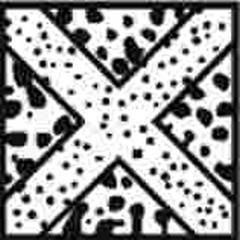 | 1. Prohibition of landingA horizontal red square panel with yellow diagonals when displayed in a signal area indicates that landings are prohibited and that the prohibition is liable to be prolonged. |
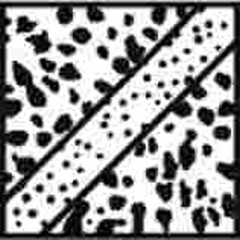 | 2. Need for special precautions while approaching or landing A horizontal red square panel with one yellow diagonal when displayed in a signal area indicates that owing to the bad state of the manoeuvring area, or for any other reason, special precautions must be observed in approaching to land or in landing. |
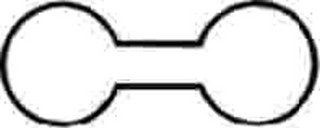 | 3. Use of runways and taxiways A horizontal white dumb-bell when displayed in a signal area indicates that aircraft are required to land, take off and taxi on runways and taxiways only. |
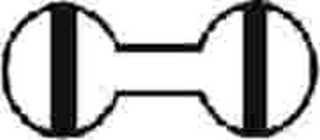 | A horizontal white dumb-bell with a black bar placed perpendicular to the shaft across each circular portion of the dumb-bell when displayed in a signal area indicates that aircraft are required to land and take off on runways only, but other manoeuvres need not be confined to runways and taxiways. |
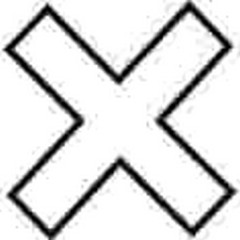 | 4. Closed runways or taxiways Crosses of a single contrasting colour, yellow or white displayed horizontally on runways and taxiways or parts thereof indicate an area unfit for movement of aircraft. |
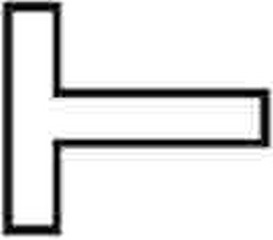 | 5. Directions for landing or take-off A horizontal white or orange landing T indicates the direction to be used by aircraft for landing and take-off, which shall be in a direction parallel to the shaft of the T towards the cross arm. When used at night, the landing T shall be either illuminated or outlined in white lights. |
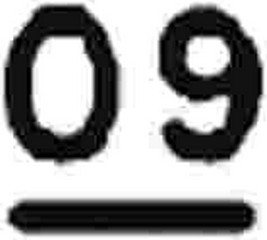 | A set of two digits displayed vertically at or near the aerodrome control tower indicates to aircraft on the manoeuvring area the direction for take-off, expressed in units of 10 degrees to the nearest 10 degrees of the magnetic compass. |
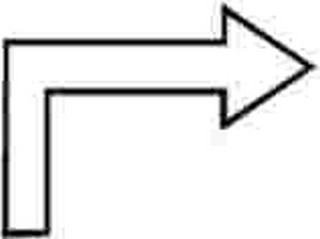 | 6. Right-hand circuit When displayed in a signal area, or horizontally at the end of the runway or strip in use, a right-hand arrow of conspicuous colour indicates that turns are to be made to the right before landing and after take-off. |
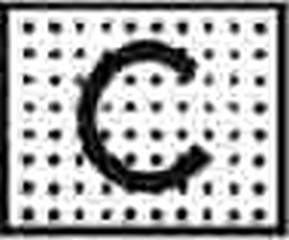 | 7. ATS reporting office The letter C displayed vertically in black against a yellow background indicates the location of the ATS reporting office. |
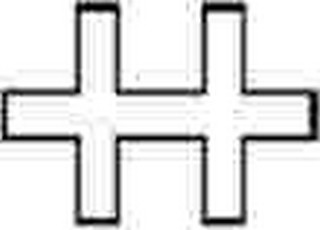 | 8. Sailplane flights in operation A double white cross displayed horizontally in the signal area indicates that the aerodrome is being used by sailplanes and that sailplane flights are being performed. |
1.7.4 Marshalling Signals
1.7.4.1 From a Signalman/Marshaller to an Aircraft
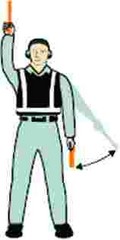 | 1. Wingwalker/guide (*) Right hand raised above head level with wand pointing up; left-hand wand moved pointing down toward body. (*) This signal provides an indication by a person positioned at the aircraft wing tip, to the pilot/marshaller/push-back operator, that the aircraft movement on/off a parking position would be unobstructed. |
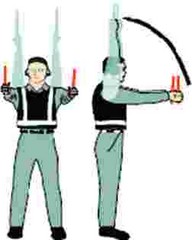 | 2. Identify gate Fully extended arms raised straight above head with wands pointing up. |
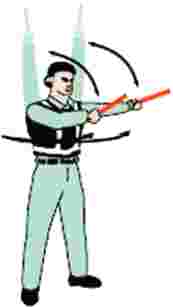 | 3. Proceed to next signalman/marshaller or as directed by tower/ground controlBoth arms pointed upward; arms moved and extended outward to sides of body and wands pointed to direction of next signalman/marshaller or taxi area. |
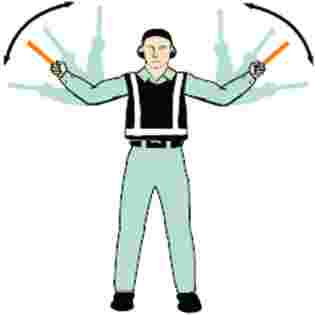 | 4. Straight aheadExtended arms bended at elbows and wands moved up and down from chest height to head. |
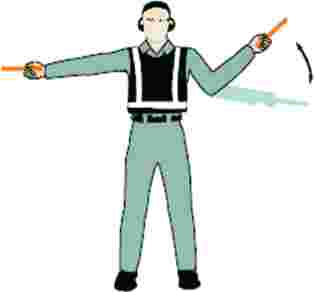 | 5(a). Turn left (from pilot’s point of view)With right arm and wand extended at a 90° angle to body, ‘come ahead’ signal made with left hand. The rate of signal motion indicates the rate of aircraft turn. |
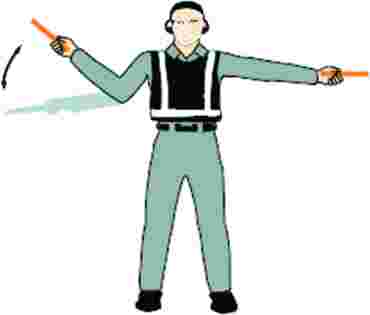 | 5(b). Turn right (from pilot’s point of view)With left arm and wand extended at a 90° angle to body, ‘come ahead’ signal made with right hand. The rate of signal motion indicates the rate of aircraft turn. |
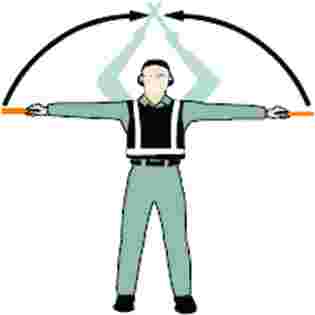 | 6(a). Normal stopArms fully extended and wands at a 90° angle to sides and slowly moved to above head until wands cross. |
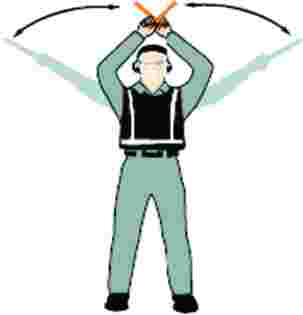 | 6(b). Emergency stopArms and wands abruptly extended to top of head, crossing wands. |
 | 7(a). Set brakesHand raised just above shoulder height with open palm. After eye contact, hand closed into a fist. “Thumbs up” acknowledgement required by flight crew before marshaller may move. |
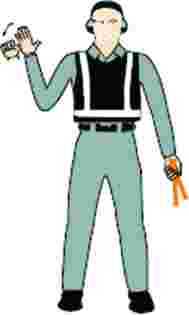 | 7(b). Release brakesHand raised just above shoulder height with hand closed in a fist. After eye contact, palm opened. “Thumbs up” acknowledgement required by flight crew before marshaller may move. |
 | 8(a). Chocks insertedArms and wands fully extended above head, wands moved inward in a ‘jabbing’ motion until wands touch. Acknowledgement shall be given by flight crew. |
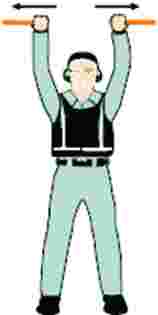 | 8(b). Chocks removedArms and wands fully extended above head, wands moved outward in a ‘jabbing’ motion. Chocks will not be removed until authorisation is given by flight crew. |
 | 9. Start engine(s)Right arm raised to head level with wand pointing up and circular motion started with hand; at the same time, left arm raised above head level, pointing to engine to be started. |
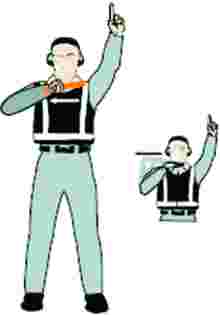 | 10. Cut enginesArm extended with wand forward of body at shoulder level; hand and wand moved to top of left shoulder and wand drawn to top of right shoulder in a slicing motion across throat. |
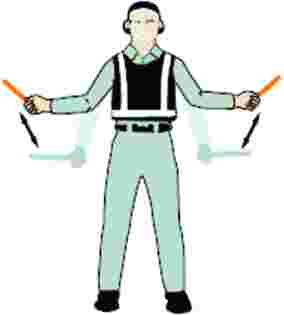 | 11. Slow downExtended arms moved downwards in a ‘patting’ gesture, wands moved up and down from waist to knees. |
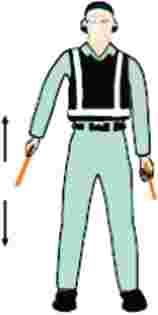 | 12. Slow down engine(s) on indicated sideWith arms down and wands toward ground, either right or left wand waved up and down indicating engine(s) on left or right side respectively should be slowed down. |
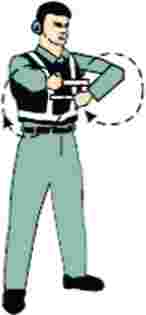 | 13. Move backWith arms in front of body at waist height, arms rotated in a forward motion. |
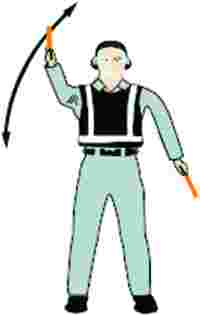 | 14(a). Turns while backing (for tail to starboard)Left arm pointed with wand down and right arm brought from overhead vertical position to horizontal forward position, repeating right-arm movement. |
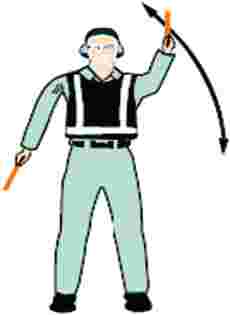 | 14(b). Turns while backing (for tail to port)Right arm pointed with wand down and left arm brought from overhead vertical position to horizontal forward position, repeating left-arm movement. |
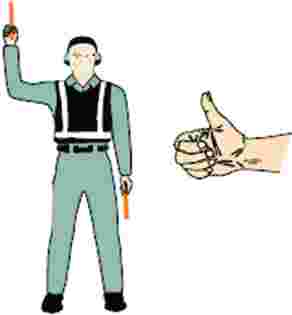 | 15. Affirmative/all clear (*)Right arm raised to head level with wand pointing up or hand displayed with ‘thumbs up’; left arm remains at side by knee. (*) This signal is also used us a technical/servicing communication signal. |
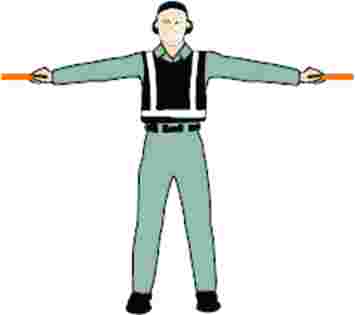 | 16. Hover (*)Arms fully extended and wands at a 90° angle to sides. (*) For use to hovering helicopters |
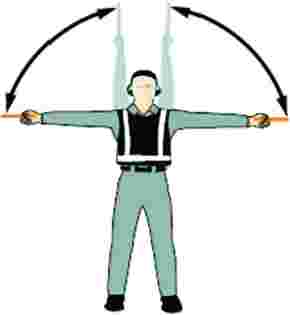 | 17. Move upwards (*)Arms and wands fully extended at a 90° angle to sides and, with palms turned up, hands moved upwards. Speed of movement indicates rate of ascent. (*) For use to hovering helicopters |
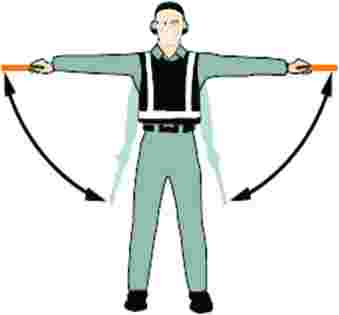 | 18. Move downwards (from pilot’s point of view) (*)Arms and wands fully extended at a 90° angle to sides and, with palms turned down, hands moved downwards. Speed of movement indicates rate of descent. (*) For use to hovering helicopters |
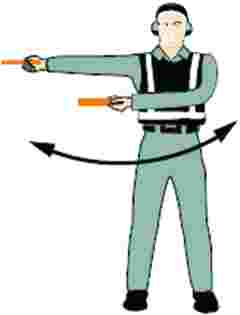 | 19(a). Move horizontally left (from pilot’s point of view) (*)Arm extended horizontally at a 90° angle to right side of body. Other arm moved in same direction in a sweeping motion. (*) For use to hovering helicopters |
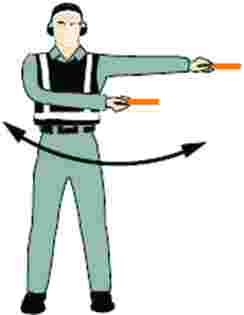 | 19(b). Move horizontally right (*)Arms extended horizontally at a 90-degree angle to left side of body. Other arm moved in same direction in a sweeping motion. (*) For use to hovering helicopters |
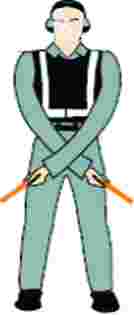 | 20. Land (*)Arms crossed with wands downwards and in front of body. (*) For use to hovering helicopters |
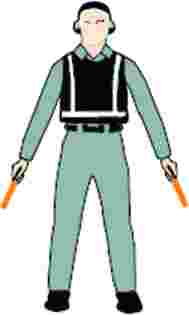 | 21. Hold position/stand byArms and wands fully extended downwards at a 45° angle to sides. |
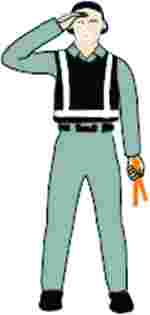 | 22. Dispatch aircraftStandard salute with right hand and/or wand. Eye contact with marshaller shall be maintained until aircraft begins to taxi. |
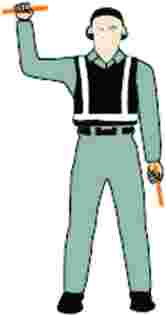 | 23. Do not touch controls (technical/servicing communication signal)Right arm fully extended above head and fist closed or wand hold in horizontal position; left arm remains at side by knee. |
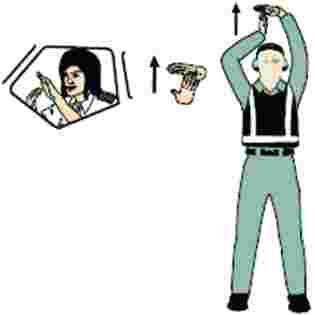 | 24. Connect ground power (technical/servicing communication signal)Arms fully extended above head; left hand opened horizontally and finger tips of right hand moved into and touched open palm of left hand (forming a ‘T’). At night, illuminated wands can also be used to form the ‘T’ above head. |
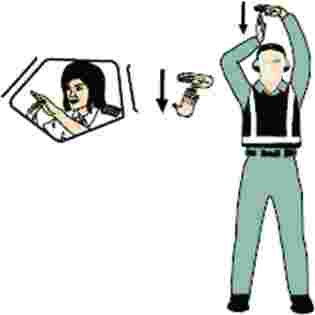 | 25. Disconnect power (technical/servicing communication signal)Arms fully extended above head with finger tips of right hand touching open horizontal palm of left hand (forming a ‘T’); then right hand moved away from the left. Power will not be disconnected until authorised by flight crew. At night, illuminated wands can also be used to form the ‘T’ above head. |
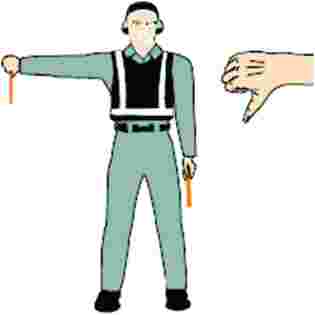 | 26. Negative (technical/servicing communication signal)Right arm straight out at 90° from shoulder and wand pointed down to ground or display hand with ‘thumbs down’; left hand remains at side by knee. |
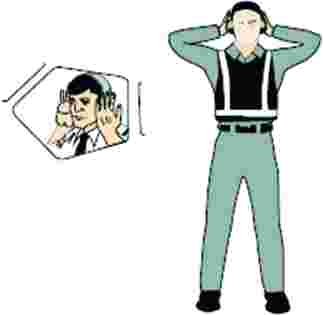 | 27. Establish communication via interphone (technical/servicing communication signal)Both arms extended at 90° from body and hands moved to cup both ears. |
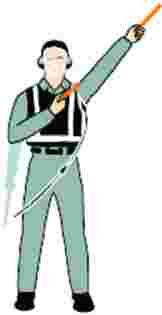 | 28. Open/close stairs (technical/servicing communication signal) (*)Right arm at side and left arm raised above head at a 45° angle, right arm moved in a sweeping motion towards top of left shoulder. (*) This signal is intended mainly for aircraft with the set of integral stairs at the front. |
1.7.4.2 From the Pilot of an Aircraft to a Signalman/Marshaller
Pilots in the cockpit shall use the following signals with hands plainly visible to the signalman/marshaller, and illuminated as necessary to facilitate observation by the signalman/marshaller:
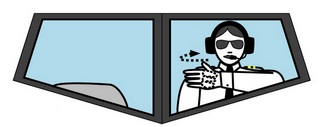 | 1. Brakes engagedRaise arm and hand, with fingers extended, horizontally in front of face, then clench fist. |
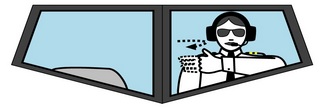 | 2. Brakes releasedRaise arm, with fist clenched, horizontally in front of face, then extend fingers. |
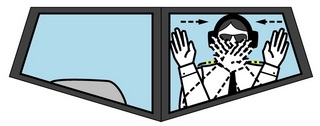 | 3. Insert chocksArms extended, palms outwards, move hands inwards to cross in front of face. |
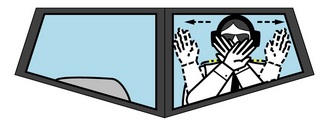 | 4. Remove chocksHands crossed in front of face, palms outwards, move arms outwards. |
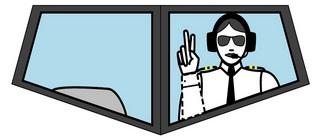 | 5. Ready to start enginesRaise the appropriate numbers of fingers on one hand indicating the number of the engine to be started. |
1.7.5 Standard Emergency Hand Signals
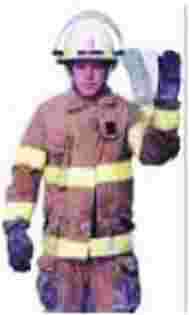 | 1. Recommend evacuationEvacuation recommended based on aircraft rescue and fire-fighting and Incident Commander’s assessment of external situation.Arm extended from body, and held horizontal with hand upraised at eye level. Beckoning arm motion angled backward. Non-beckoning arm held against body. Night - same with wands. |
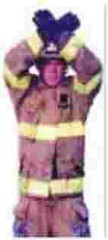 | 2. Recommend stopRecommend evacuation in progress be halted. Stop aircraft movement or other activity in progress. Arms in front of head - Crossed at wrists. Night - same with wands. |
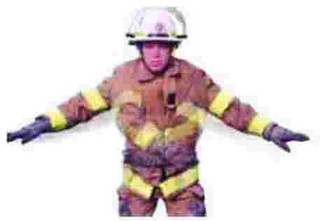 | 3. Emergency containedNo outside evidence of dangerous conditions or ‘all-clear.’Arms extended outward and down at a 45° angle. Arms moved inward below waistline simultaneously until wrists crossed, then extended outward to starting position. Night - same with wands. |
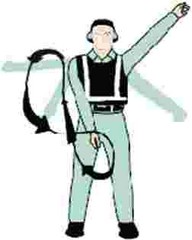 | 4. FireRight-hand moved in a ‘fanning’ motion from shoulder to knee, while at the same time left hand is pointing to area of fire. Night - same with wands. |
1.8 Time (SERA.3401)
A time check shall be obtained prior to operating a controlled flight and at such other times during the flight as may be necessary.
Wherever time is utilised in the application of data link communications, it shall be accurate to within 1 second of UTC.
1.9 Requirements for Communications and SSR Transponder (SERA.6005)
1.9.1 Radio Mandatory Zone (RMZ)
VFR flights operating in parts of class E, F or G airspace and IFR flights operating in parts of class F or G airspace designated as a radio mandatory zone (RMZ) shall maintain continuous air-ground voice communication watch and establish two-way communication, as necessary, on the appropriate communication channel, unless in compliance with alternative provisions prescribed for that particular airspace by the ATS authority.
Before entering a radio mandatory zone, an initial call containing the designation of the station being called, call sign, type of aircraft, position, level, the intentions of the flight and other information as prescribed by the appropriate ATS unit, shall be made by pilots on the appropriate communication channel.
1.9.2 Transponder Mandatory Zone (TMZ)
All flights operating in airspace designated as a transponder mandatory zone (TMZ) shall carry and operate SSR transponders capable of operating on Modes A and C or on Mode S, unless in compliance with alternative provisions prescribed for that particular airspace by the ATS authority.
1.10 Air Traffic Control Service
1.10.1 Air Traffic Control Clearances (SERA.8015)
1.10.1.1 Operation subject to clearance
An ATC clearance shall be obtained prior to operating a controlled flight, or a portion of a flight as a controlled flight. Such clearance shall be requested through the submission of a flight plan to an air traffic control unit.
The pilot-in-command of an aircraft shall inform ATC if an ATC clearance is not satisfactory. In such cases, ATC will issue an amended clearance, if practicable.
Whenever an aircraft has requested a clearance involving priority, a report explaining the necessity for such priority shall be submitted, if requested by the appropriate ATC unit.
If, prior to departure, it is anticipated that, depending on fuel endurance and subject to re-clearance in flight, a decision may be taken to proceed to a revised destination aerodrome, the appropriate ATC units shall be so notified by the insertion in the flight plan of information concerning the revised route (where known) and the revised destination.
An aircraft operated on a controlled aerodrome shall not taxi on the manoeuvring area without clearance from the aerodrome control tower and shall comply with any instructions given by that unit.
1.10.1.2 Read-back of clearances and safety-related information
The flight crew shall read back to the air traffic controller safety-related parts of ATC clearances and instructions which are transmitted by voice. The following items shall always be read back:
- ATC route clearances;
- clearances and instructions to enter, land on, take off from, hold short of, cross, taxi and backtrack on any runway
- runway-in-use, altimeter settings, SSR codes, newly assigned communication channels, level instructions, heading and speed instructions;
- transition levels, whether issued by the controller or contained in ATIS broadcasts.
Other clearances or instructions, including conditional clearances and taxi instructions, shall be read back or acknowledged in a manner to clearly indicate that they have been understood and will be complied with.
Voice read-back of CPDLC messages shall not be required, unless otherwise specified by the responsible ATS authority.
1.10.1.3 Coordination of clearances
When prescribed by the ATS unit, aircraft shall contact a downstream ATC unit, for the purpose of receiving a downstream clearance prior to the transfer of control point. Aircraft shall maintain the necessary two-way communication with the current air traffic control unit whilst obtaining a downstream clearance.
1.10.2 Adherence to Flight Plan (SERA.8020)
1.10.2.1 General
Except as provided for in § 1.10.2.2 and § 1.10.2.4 below, an aircraft shall adhere to the current flight plan or the applicable portion of a current flight plan submitted for a controlled flight unless a request for a change has been made and clearance obtained from the appropriate ATC unit, or unless an emergency situation arises which necessitates immediate action by the aircraft, in which event as soon as circumstances permit, after such emergency authority is exercised, the appropriate ATS unit shall be notified of the action taken and that this action has been taken under emergency authority.
Unless otherwise authorized or directed by the appropriate ATC unit, controlled flights shall, in so far as practicable:
- when on an established ATS route, operate along the defined centre line of that route;
- when on any other route, operate directly between the navigation facilities and/or points defining that route.
Unless otherwise authorised or directed by the appropriate ATC unit, an aircraft operating along an ATS route segment defined by reference to VOR shall change over for its primary navigation guidance from the facility behind the aircraft to that ahead of it at, or as close as operationally feasible to, the changeover point, where established. Deviation from this requirement shall be notified to the appropriate ATS unit.
1.10.2.2 Inadvertent Changes
In the event that a controlled flight inadvertently deviates from its current flight plan, the following action shall be taken:
- Deviation from track: If the aircraft is off track, action shall be taken forthwith to adjust the heading of the aircraft to regain track as soon as practicable;
- Variation in true airspeed: If the average true airspeed at cruising level between reporting points varies or is expected to vary by plus or minus 5 per cent of the true airspeed, from that given in the flight plan, the appropriate ATS unit shall be so informed;
- Change in time estimate: If the time estimate for the next applicable reporting point, FIR boundary or destination aerodrome, whichever comes first, is found to be in error in excess of 2 MIN from that notified to ATS, a revised estimated time shall be notified as soon as possible to the appropriate ATS unit;
- Additionally, when an ADS-C agreement is in place, the ATS unit shall be informed automatically via data link whenever changes occur beyond the threshold values stipulated by the ADS-C event contract.
1.10.2.3 Intended Changes
Requests for flight plan changes shall include information as indicated hereunder:
- Change of cruising level: aircraft identification, requested new cruising level and cruising speed at this level, revised time estimates (when applicable) at subsequent FIR boundaries;
- Change of route:
- Destination unchanged: aircraft identification, flight rules, description of new route of flight including related flight plan data beginning with the position from which requested change of route is to commence, revised time estimates and any other pertinent information;
- Destination changed: aircraft identification, flight rules, description of revised route of flight to revised destination aerodrome including related flight plan data beginning with the position from which requested change of route is to commence, revised time estimates, alternate aerodrome(s) and any other pertinent information.
1.10.2.4 Weather Deterioration below the VMC
When it becomes evident that flight in VMC in accordance with its current flight plan will not be practicable, a VFR flight operated as a controlled flight shall either:
- request an amended clearance enabling the aircraft to continue in VMC to destination or to an alternative aerodrome, or to leave the airspace within which an ATC clearance is required;
- if no clearance in accordance with (a) can be obtained, continue to operate in VMC and notify the appropriate ATC unit of the action being taken either to leave the airspace concerned or to land at the nearest suitable aerodrome;
- if operated within a CTR, request authorization to operate as a special VFR flight;
- request clearance to operate in accordance with the instrument flight rules.
1.10.3 Position Reports (SERA.8025)
Unless exempted by the competent ATS authority or by the appropriate ATS unit under conditions specified by that authority, a controlled flight shall report to the appropriate ATS unit, as soon as possible, the time and level of passing each designated compulsory reporting point, together with any other required information. Position reports shall similarly be made in relation to additional points when requested by the appropriate ATS unit. In the absence of designated reporting points, position reports shall be made at intervals prescribed by the appropriate ATS authority or specified by the appropriate ATS unit.
Controlled flights providing position information to the appropriate ATS unit via data link communications shall only provide voice position reports when requested.
When a controlled flight has been exempted from the requirement to report over compulsory reporting points pilots shall, unless automated position reporting is in effect, resume voice or CPDLC position reporting:
- when so instructed;
- when advised that the ATS surveillance service has been terminated, or;
- when advised that the ATS surveillance identification is lost.
The format of position reports shall be in accordance with Model AIREP special.
1.10.4 Termination of Control (SERA.8030)
A controlled flight shall, except when landing at a controlled aerodrome, advise the appropriate ATC unit as soon as it ceases to be subject to ATC.
1.10.5 Communications (SERA.8035)
1.10.5.1 General
An aircraft operated as a controlled flight shall maintain continuous air-ground voice communication watch on the appropriate communication channel of, and establish two-way communication as necessary with, the appropriate ATC unit, except as may be prescribed by the relevant ATS authority in respect of aircraft forming part of aerodrome traffic at a controlled aerodrome.
The requirement for an aircraft to maintain an air-ground voice communication watch shall remain in effect when CPDLC has been established.
Note 1: Aircraft with a MTOW of 136 000 KG or more shall include the word “heavy” immediately after the aircraft call sign at initial contact with ATC.
Note 2: Student pilots should include the word “solo” immediately after the aircraft call sign at initial contact with each ATS unit or Basic Information unit.
1.10.5.2 Communication Failure in VMC
A controlled flight experiencing communication failure in VMC shall:
- set transponder to Code 7600;
- continue to fly in VMC;
- land at the nearest suitable aerodrome;
- report its arrival by the most expeditious means to the appropriate ATS unit.
1.10.5.3 Communication Failure in IMC
A controlled flight experiencing communication failure in IMC, or where it does not appear feasible to continue in accordance with VMC shall:
- set transponder to Code 7600;
- maintain for a period of 7 MIN the last assigned speed and level. The period of 7 MIN starts:
- if operating on a route without compulsory reporting points or if instructions have been received to omit position reports either:
- at the time the last assigned level is reached, or
- at the time the transponder is set to Code 7600, whichever is later;
- if operating on a route with compulsory reporting points and no instruction to omit position reports has been received either:
- at the time the last assigned level is reached, or
- at the previously reported pilot estimate for the compulsory reporting point, or
- at the time of a failed report of position over a compulsory reporting point, whichever is later;
- if operating on a route without compulsory reporting points or if instructions have been received to omit position reports either:
- thereafter, adjust level and speed in accordance with the filed flight plan;
- if being radar vectored or proceeding offset according to RNAV without a specified limit, proceed in the most direct manner possible to re-join the current flight plan route, including any changes brought about by subsequent clearances, not later than the next significant point;
- proceed according to the current flight plan route to the appropriate designated navigation aid serving the destination aerodrome and, when required to ensure compliance with item (f) below, hold over this aid until commencement of descent;
- commence descent from the navigation aid specified in item (e) at, or as close as possible to, the EAT last received and acknowledged or, if no EAT has been received and acknowledged, at, or as close as possible to, the ETA resulting from the current flight plan;
- complete a normal instrument approach procedure as specified for the designated navigation aid;
- land, if possible, within 30 MIN after the ETA specified in item (f) or the last acknowledged EAT, whichever is later.
Note: The pilot who is given the following message “Delay not determined, X ... aircraft holding for weather improvement” shall not consider it as an EAT for the purpose of the radio communication failure procedures. Pilots whose radio fails after they have received this message, but before an EAT is given, shall not attempt to land at their planned aerodrome of destination but should fly at their assigned level to an area in which VMC prevail and where they can approach and land visually at a suitable aerodrome.
1.11 Minimum fuel and fuel emergency (SERA.11012)
When a pilot reports a state of minimum fuel, the controller will inform the pilot as soon as practicable of any anticipated delays or that no delays are expected.
When the level of fuel renders declaring a situation of distress necessary, the pilot, in accordance with SERA.14095, shall indicate this by using the radiotelephony distress signal (MAYDAY), preferably spoken 3 times, followed by the nature of the distress condition (FUEL).
1.12 Degraded aircraft performance (SERA.11013)
1.12.1 General
Whenever, as a result of failure or degradation of navigation, communications, altimetry, flight control or other systems, aircraft performance is degraded below the level required for the airspace in which it is operating, the flight crew shall advise the ATC unit concerned without delay. Where the failure or degradation affects the separation minimum currently being employed, the controller will take action to establish another appropriate type of separation or separation minimum.
1.12.2 Degradation or failure of the RNAV system
When an aircraft cannot meet the specifications, as required by the RNAV/RNP airspace, route or procedure, as a result of a failure or degradation of the RNAV system, a revised clearance shall be requested by the pilot.
1.12.3 Loss of vertical navigation performance required for reduced vertical separation minima (RVSM) airspace
- The pilot shall inform ATC as soon as possible of any circumstances where the vertical navigation performance requirements for RVSM airspace cannot be maintained. In such cases, the pilot shall obtain a revised ATC clearance prior to initiating any deviation from the cleared route and/or flight level, whenever possible. When a revised ATC clearance cannot be obtained prior to such a deviation, the pilot shall obtain a revised clearance as soon as possible thereafter.
- During operations in or vertical transit through reduced vertical separation minimum (RVSM) airspace with aircraft not approved for RVSM operations, pilots shall report non-approved status as follows:
- at initial call on any channel within RVSM airspace;
- in all requests for level changes; and
- in all readbacks of level clearances.
- Air traffic controllers will explicitly acknowledge receipt of messages from aircraft reporting RVSM non-approved status.
- Degradation of aircraft equipment – pilot reported
- When informed by the pilot of an RVSM-approved aircraft operating in RVSM airspace that the aircraft’s equipment no longer meets the RVSM requirements, ATC will consider the aircraft as non-RVSM-approved.
- Pilots shall inform ATC, as soon as practicable, of any restoration of the proper functioning of equipment required to meet the RVSM requirements.
- Severe turbulence – not forecast
- When an aircraft operating in RVSM airspace encounters severe turbulence due to weather or wake vortex that the pilot believes will impact the aircraft’s capability to maintain its cleared flight level, the pilot shall inform ATC. ATC will establish either an appropriate horizontal separation or an increased minimum vertical separation.
- ATC will, to the extent possible, accommodate pilot requests for flight level and/or route changes and will pass on traffic information as required.
- ATC will solicit reports from other aircraft to determine whether RVSM should be suspended entirely or within a specific flight level band and/or area.
- The ACC suspending RVSM will coordinate with adjacent ACCs such suspension(s) and any required adjustments to sector capacities, as appropriate, to ensure an orderly progression to the transfer of traffic.
- Severe turbulence – forecast
- When a meteorological forecast predicts severe turbulence within RVSM airspace, ATC will determine whether RVSM should be suspended and, if so, for how long and for which specific flight level(s) and/or area.
- In cases where RVSM will be suspended, the ACC suspending RVSM will coordinate with adjacent ACCs with regard to the flight levels appropriate for the transfer of traffic, unless a contingency flight level allocation scheme has been determined by letter of agreement. The ACC suspending RVSM will also coordinate with adjacent ACCs applicable sector capacities, as appropriate.
1.13 ACAS Resolution advisory (RA) (SERA.11014)
In the event of an ACAS RA, pilots shall:
- respond immediately by following the RA as indicated, unless doing so would jeopardize the safety of the aeroplane;
- follow the RA even if there is a conflict between the RA and an ATC instruction to manoeuvre;
- not manoeuvre in the opposite sense to an RA;
- as soon as possible, as permitted by flight crew workload, notify the appropriate ATC unit of any RA which requires a deviation from the current ATC instruction or clearance;
- promptly comply with any modified RAs;
- limit the alterations of the flight path to the minimum extent necessary to comply with the RAs;
- promptly return to the terms of the ATC instruction or clearance when the conflict is resolved; and
- notify ATC when returning to the current clearance.
When a pilot reports an ACAS resolution advisory (RA), the controller will not attempt to modify the aircraft flight path until the pilot reports ‘CLEAR OF CONFLICT’.
Once an aircraft departs from its ATC clearance or instruction in compliance with an RA, or a pilot reports an RA, the controller ceases to be responsible for providing separation between that aircraft and any other aircraft affected as a direct consequence of the manoeuvre induced by the RA. The controller will resume responsibility for providing separation for all the affected aircraft when:
- the controller acknowledges a report from the flight crew that the aircraft has resumed the current clearance, or
- the controller acknowledges a report from the flight crew that the aircraft is resuming the current clearance and issues an alternative clearance which is acknowledged by the flight crew.
1.14 Special aircraft observations (SERA.12005)
Special observations shall be made and reported by all aircraft whenever the following conditions are encountered or observed:
- moderate or severe turbulence; or
- moderate or severe icing; or
- severe mountain wave; or
- thunderstorms, without hail, that are obscured, embedded, widespread or in squall lines; or
- thunderstorms, with hail, that are obscured, embedded, widespread or in squall lines; or
- heavy dust storm or heavy sandstorm; or
- volcanic ash cloud; or
- pre-eruption volcanic activity or a volcanic eruption.
Flight crews shall compile the reports using forms based on the model AIREP SPECIAL form. The detailed instructions for reporting, shall be complied with.
- The detailed instructions, including the formats of messages and the phraseologies shall be used by flight crews when transmitting air-reports and by air traffic services units when retransmitting such reports.
- Special air-reports containing observations of volcanic activity shall be recorded on the special air-report of volcanic activity form. Forms based on the model form for special air-reports of volcanic activity shall be provided for flight crews operating on routes which could be affected by volcanic ash clouds.
1.15 Supplementary Rules
1.15.1 Ultra-Light Motorized Aircraft
1.15.1.1 In Belgium
Flights with ULM shall only take place during HJ, in VMC, with ground or water in sight and with a visibility of minimum 3 KM.
Unless authorised by the appropriate ATS unit, ULM shall not be flown in controlled airspace.
Unless authorised by the CAA, ULM shall not be flown:
- over cities, residential areas, industrial installations or an open-air assembly of people;
- in prohibited, restricted or danger areas.
ULM shall not be used for aerobatic flights.
1.15.1.2 In Luxembourg
Flights with ULM shall only take place during HJ, in VMC and at an altitude of maximum 3 500 FT AMSL or 1 000 FT AGL, whichever is higher. Except for landing or take-off, no flight shall be performed below 50 M AGL.
Unless authorised by the competent ATS authority, ULM shall not be flown in Luxembourg TMA. In order to obtain such authorisation, the pilot of an ULM shall be holder of an RTF qualification and be able to maintain two-way communications with ATS.
ULM shall not be used for aerobatic flights.
1.15.2 Lighter-than-air Aircraft, Tele-guided Devices, Rockets and Kites
1.15.2.1 In Belgium
The authorisation of the CAA is needed in case of:
- ascents of manned free gas balloons over the congested areas of cities, towns or settlements;
- ascents of airships and captive balloons;
- operation of devices that might cause damage to aircraft in flight such as tele-guided devices, rockets or kites.
Manned free balloons shall not enter controlled airspace unless an ATC clearance has been obtained before ascent and at least 10 MIN before entering the controlled airspace. When entering the controlled airspace, two-way radiocommunications shall be established and maintained with the appropriate control unit.
It is recommended to notify all ascents of manned free balloons to Brussels FIC by phone (+32 (0) 2 206 27 31) or via the operational website of skeyes (ops.skeyes.be - for registered users only) at least one hour before the estimated time of departure. Following information should be provided:
- identification of the balloon;
- name of the pilot;
- telephone number of the place where the pilot can eventually be contacted until the start of the ascent;
- location of the ascent;
- estimated time (UTC) of the ascent;
- estimated time of the flight, maximum altitude and estimated track.
Note 1: In case of loss of two-way radio communications, manned free balloons shall immediately leave the airspace for which a clearance had been obtained.
Note 2: When notifying the balloon flight via the Internet, a confirmation form will be displayed. The internet balloon notification form cannot be used for flights crossing international borders. In this case an appropriate ICAO flight plan shall be filed.
1.15.2.2 In Luxembourg
Captive balloon and kite ascents above 100 M AGL are subject to authorization from the CAA. These ascents are in any case forbidden in each approach sector of an aerodrome up to 100 M on either side of the extended runway centre line from the runway threshold up to a distance of 2 KM before threshold.
Manned free balloons and airships may be operated under the following conditions:
- a balloon or an airship shall not be flown between sunset and sunrise unless it is equipped with at least one flashing light visible in all azimuths and in an angle of at least 30 degrees below and 30 degrees above the horizontal line and at a distance of at least 8 KM;
- a balloon overtaking, while climbing, has the right of way over a balloon being overtaken; the latter shall deviate by all appropriate means from the trajectory of the overtaking balloon;
- only water and/or fine sand may be used as ballast. Dropping of ballast or stays may only be done without undue hazard to persons or property on the ground;
- the operator and the pilot-in-command shall comply with the procedures laid down by the constructor in the operational and maintenance manuals.
Note: Manned balloons fixed to the ground, for any reason, are not to be considered as captive balloons.
1.15.3 Flights Requiring Special Handling by ATC
1.15.3.1 In Brussels FIR/UIR below FL 245
Flights conducted in the Brussels FIR/UIR below FL 245 (Luxembourg airspace below the upper limit of Luxembourg TMA excl) that have a specific character, requiring special handling by ATC (such as calibration flights, test flights, check flights, radio relay missions and aerial surveys) must be coordinated at least five working days in advance with the Special Activities Coordination Cell (SPACC) of skeyes, using the form available on the skeyes website (www.skeyes.be).
The SPACC will coordinate the requests with the appropriate ATS authorities and formulate a reply that contains the conditions to execute the requested mission.
The reply contains a file number “SAYYYY.NNNN”, where “YYYY” stands for the year and “NNNN” for the file number itself. Only this reference shall be used by the operator in communications with the appropriate ATS service.
The submission of a flight plan for each aircraft is compulsory. Item15 shall clearly indicate the area and/or route and/or place of the mission and item 18 shall include the reference number (e.g. “RMK/PHOTOMISSION SAYYYY.NNNN” or “RMK/RADIO RELAY SAYYYY.NNNN”).
1.15.3.2 In Brussels UIR above FL 245
Flights conducted in the Brussels UIR above FL 245 that have a specific character, requiring special handling by ATC (such as calibration flights, test flights, check flights, etc.) must be coordinated at least 24 HR in advance with Maastricht UAC by filling the web form available from https://www.eurocontrol.int/muac#operational-contacts or by sending an email with equivalent content to masuac.testflights@eurocontrol.int to obtain acceptance.
Supplementary contact: Executive Duty Supervisor
TEL: +31 43 366 2022
FAX: +31 43 366 1320
2 MILITARY
2.1 Introduction
2.1.1 General Air Traffic
General Air Traffic (GAT): Flights conducted in accordance with the regulations and procedures promulgated by the State Civil Aviation authorities and operating under the control or authority of the civil ATS organization.
2.1.2 Operational Air Traffic
2.1.2.1 General
Operational Air Traffic (OAT): Flights that do not necessarily comply with the provisions stated for GAT and for which rules and procedures have been specified by appropriate authorities. OAT is allowed during Steenokkerzeel ATCC OPS hours only (see GEN 3.3).
Outside OPS hours, Steenokkerzeel ATCC does not provide any ATS (nor ATC nor FIS). Planned military flights outside the OPS hours shall therefore:
- file a GAT FPL (Remark: The MIL TACAN routes TG1 and TL4 cannot be filed GAT); or obtain special permission from COMOPSAIR to file OAT (72 HR in advance, see ENR 1.10, § 2.1);
- and, contact the civil FIC when entering uncontrolled airspace.
Belgian or foreign QRA aircraft flying in the Brussels FIR/UIR outside Steenokkerzeel ATCC OPS hours will be under control of CRC Beauvechain or under control of an aerodrome ATS unit during their mission.
Controlled flights are:
- flights conducted within controlled airspace and receiving a control service,
- flights in TRA and in TSA above 4500 FT AMSL, and
flights performing an air defence mission (see § 2.16).
Uncontrolled VFR flights are authorised below 4500 FT AMSL, outside controlled airspace (see ENR 1.2, § 2.5).
Within airspace controlled by military authorities, military pilots shall comply with OAT regulations in accordance with ATS airspace classification. In airspace controlled by civil authorities, pilots should comply with GAT regulations. Military pilots shall cross ATS routes and airways under radar control. If no contact can be established with Steenokkerzeel ATCC, the appropriate civil ATS unit shall be contacted for crossing clearance.
All military activity in Belgian airspace above 4 500 FT AMSL require an airspace reservation (see ENR 5.2, § 1.3, optional for transiting Belgian military aircraft) and a correct FPL (see ENR 1.10). Transits of foreign aircraft require only a correct FPL (see ENR 1.10) but shall adhere to the airspace permeability rules (see ENR 5.2, § 1.2).
Note: If Police flights are unable to comply with the regulations laid down in this AIP, derogation must be obtained from COMOPSAIR Air Operations Support.
2.1.2.2 EUROAT
The Eurocontrol specification for harmonized rules for OAT under Instrument Flight Rules inside controlled airspace of the ECAC area (EUROAT) is applicable within the Brussels FIR/UIR.
The following national exceptions to EUROAT apply:
Applicability of ICAO Rules of the Air
“Foreign military flights may be conducted according GAT or OAT rules, depending upon operational requirements of the mission.
Flight Plan
Specific regulations related to FPL are laid down in ENR 1.10.
Communication
For operational reason, Belgian military aircraft are not required to maintain a continuous listening watch on guard frequency.
The carriage of a serviceable mode S (ELS or EHS) SSR transponder is highly recommended but not yet compulsory for state aircraft flying OAT within the Brussels FIR/UIR including low level VFR flights.
For RPAS flights, the Belgian Military Aviation Authority may approve alternative methods of communication that provide an equivalent level of safety.
Altimeter setting procedures
Specific regulations related to altimeter setting procedures are laid down in ENR 1.7.
Speed limitation
Specific regulations related to Speed limitation are laid down in § 2.15.3.
Military formation flight
Specific regulations related to military formation flight are laid down in § 2.3.2.
Supersonic flights
Specific regulations related to supersonic flights are laid down in § 2.9.
Flight in an Airspace Reservation
Even when declaring MARSA aircraft will receive TRA service. TRA service see GEN 3.3, § 3.2.2.
When flying an air defense mission the pilot shall receive Close Positive or Loose Positive Control (see § 2.16.2), therefore MARSA can not be declared.
Radio communication failure
Specific regulations related to radio communication failure are laid down in ENR 1.6, § 2.4.
Formation lost wingman (lost lead)
National procedures differ from the definition given by EUROAT.
2.2 Compliance with the Rules of the Air
The operation of an aircraft either in flight or on the movement area of an aerodrome shall be in compliance with the general rules and shall, when in flight, be conform the ATS airspace classification (see ENR 1.4) and in addition, either with:
2.3 Separation
2.3.1 Minimum Separation
2.3.1.1 Separation applied by the Pilot-in-Command
When, in accordance with airspace classification, separation is the responsibility of the pilot-in-command, a minimum standard separation shall be maintained.
- Military aircraft shall not be flown closer than 2 000 FT horizontally to civil aircraft, military transport aircraft or military light aircraft.
- Military aircraft shall not be flown closer than 1 NM to helicopters.
- It is prohibited to position an aircraft in close formation with a high-winged aircraft without the knowledge of the pilot-in-command of the latter.
- It is prohibited to simulate attacks on training aircraft, aircraft participating to air refuelling operations and on helicopters operating in the HTA.
2.3.1.2 Radar Separation
When, in accordance with airspace classification, separation is the responsibility of the air traffic/defence controller, the regulations laid down in ICAO Doc 4444, ICAO Doc 7030 and ICAO Doc 9574 apply.
In military CTR and military TMA, horizontal separation can be reduced to:
- 3 NM when the aircraft are within 40 NM of the Radar antenna, with a 5 sec radar refresh rate minimum (Forapproach control purpose only).
- 2.5 NM between succeeding aircraft which are established on the same final approach track within 10 NM ofthe runway end. A reduced separation of minimum of 2.5 NM may be applied, provided:
- braking action is reported as good and runway occupancy times are not adversely affected by runwaycontaminants such as slush, snow or ice;
- a radar system with an update rate of 5 seconds or less is used and that the aircraft are within 40NM of the Radar antenna;
If the intentions of an aircraft are unknown, the vertical separation, if applied, will be enlarged to 5 000 FT in order to ensure sufficient time for the controller to react in order to have ICAO standard separation at all times. The horizontal separation to be applied to an aircraft with unknown intentions remains 5 NM.
Aircraft with unknown intentions are defined as:
- Aircraft entering or within controlled airspace, a TRA or a TSA without radio contact with the appropriate ATC/AD agency.
- Aircraft entering controlled airspace, a TRA or a TSA without clearance from the appropriate ATC/AD agency.
- Aircraft within controlled airspace, a TRA or a TSA diverging from their last received clearance.
- Aircraft on an ATS route or within a CTA with unclear intentions.
The intentions of an aircraft flying within uncontrolled airspace even without radio contact are not to be considered as unknown.
2.3.1.3 Separation (visual) applied by AD controllers
In the circuit VFR applies and consequently pilots are responsible for the separation. The controller will assist by providing all necessary information about other traffic in the CTR and by issuing clearances and instructions for sequencing. Clearances to land and to take-off are issued respecting the following rules:
- Take-off: aircraft will only be cleared for take-off when the preceding departing aircraft has crossed the end of the RWY or has commenced a turn and when the preceding landing aircraft has vacated the RWY.
- Landing: aircraft will only be cleared to land when the preceding departing aircraft has crossed the end of the RWY or has commenced a turn and when the preceding landing aircraft has vacated the RWY.
These rules do not apply to:
- Aircraft in formation.
- Aircraft landing on different RWYs when simultaneous landings are possible.
- Aircraft under operational requirements, incompatible with these rules.
2.3.2 Formation Flights
Military Authority Assumes Responsibility for Separation of Aircraft (MARSA)
MARSA acknowledges from the respective formation (mission) leader to the ATCO that the military participants involved in an OAT flight assume responsibility for separation (safety distance) between participating military aircraft, thus relieving the ATCO from his responsibility to ensure prescribed separation minima. The remaining responsibility of the ATCO is to provide prescribed separation between military aircraft engaged in MARSA operations and other non-participating IFR aircraft.
Separation
ATC is only allowed to treat a formation as a single speaking unit if all elements stay within a radius of 1 NM horizontally from the lead aircraft and within 100 FT vertically from the lead aircraft (military standard formation).
Exceptionally, a controller may increase the separation between the lead aircraft and all other elements within the formation to maximum 3 NM horizontally and/or 1 000 FT vertically. (non-standard formation)
If a formation is more widely dispersed, the elements of it shall be regarded as separate speaking units. During initial radio contact, the leader shall announce the number of aircraft and the type of formation.
To ensure that the minimum required horizontal radar separation, for each element of a military standard formation, is guaranteed with other traffic, an ATCO shall increase the minimum required horizontal radar separation from other traffic with 1 NM, in the case that the other traffic is also a military standard formation, 2 NM will be added.
For non-standard formation the minimum required horizontal and/or vertical separation with other traffic shall be increased according to the maximum cleared distance from the lead aircraft.
During radar trail departures and recoveries, a controller may allow the separation between the lead aircraft and all other elements of the formation to be higher than 3 NM horizontally and/or 1 000 FT vertically. For this type of departure / recovery, all elements of the formation shall squawk Mode 3/A and Mode C.
Radar trail departures and recovery shall only be granted by the controller if minimum radar separation with other traffic can be guaranteed for each element of the formation.
Unless otherwise coordinated, all elements of the formation shall stay within a radius of 1 NM horizontally from the lead aircraft and within 100 FT vertically from the lead aircraft whilst crossing civil controlled airspace (e.g airways) or before being transferred to a non Belgian Air Force ATS unit.
Safety distance between two or more formation flights
In the event that an aerial operation requires two or more formation flights to operate below prescribed IFR separation minima between individual formation flights, the formation leaders shall be responsible for sufficient safety distance between their individual formation flights.
This responsibility shall be accepted from the respective formation leaders by stating “MARSA”, relieving the ATCO from his responsibility to maintain prescribed IFR separation minima in regard to the formation flights concerned.
Formation break up (split)
Except in an emergency, a formation break up shall only occur after planning, advanced coordination and approval by ATC.
Prior to the planned formation break up, the formation leader shall inform ATC whether to break up the formation flight into single aircraft or elements.
The formation leader shall inform ATC about his intended aircraft/element break up sequence, call signs and position of these aircraft/elements relative to the formation leader’s aircraft. Aircraft/elements shall receive separate clearances and transponder codes from ATC.
As soon as the formation break up has been directed by ATC for the respective aircraft/element, this aircraft/element is no longer part of the previous formation flight and shall follow subsequent ATC instructions issued to them.
However, ATC shall only assume responsibility for separation between the aircraft/elements that are conducting the formation break up after prescribed separation minima have been established. Until then, the individual pilot-in command/ element-leader is responsible for maintaining sufficient safety distance.
Formation join up
When a formation join up is controlled by an ATCO, he/she shall apply standard separation criteria between individual aircraft wishing to join a formation, until the formation leader accepts responsibility for maintaining sufficient safety distance between the aircraft concerned.
The formation leader, once he is safely able to do so, shall confirm his assumption of responsibility for maintaining sufficient safety distance between his aircraft, the aircraft comprising the formation and the joining aircraft by stating “MARSA”; whereupon ATC shall transfer responsibility for the joining aircraft to the formation leader.
Lost wingman (Lost lead) procedures
In any lost wingman situation, an immediate initial safety distance between aircraft is essential for flight safety to avoid a potential mid-air collision. Therefore, each wingman losing sight/contact of the aircraft preceding him or being unable to maintain formation for other reasons shall immediately execute the procedures relevant to his flight position, while transitioning to instrument flying and resuming own navigation.
Note: Irrespective of the nationally prescribed lost wingman procedures, their execution may result in a loss of minimum IFR separation in respect to other air traffic and is an emergency situation for ATC.
Recommendation: in order to immediately alert ATC and allow to safely resolve resulting conflict potentials without undue delay, the following should be executed in addition to the appropriate lost wingman procedure:
- Formation leader squawks emergency and informs the appropriate ATC unit as soon as possible.
- Each pilot-in-command executing a lost wingman procedure squawks as directed by the appropriate ATC unit as soon as practicable.
Formation radio failure
A formation flight in which a flight member experiences total radio failure shall comply with the procedures outlined for this case within the standard operating procedures (SOP) of their appropriate national authority.
If the SOP requires deviations from a given clearance, the flight leader or the pilot of aircraft with the serviceable radio shall inform the ATC unit and request a different clearance.
In the event that the total radio failure affects all aircraft of the formation flight, the formation leader shall ensure compliance with basic ICAO radio failure procedures.
In case a formation break up is required for safe approach and landing all aircraft or element-leader of the formation flight shall squawk Mode 3, Code 7600, as soon as the break-up was initiated by the formation leader and continue to ensure compliance with basic ICAO radio failure procedures.
2.4 Airborne and traffic collision avoidance system (ACAS/TCAS)
2.4.1 Single Aircraft
If equipped with ACAS/TCAS, single aircraft shall operate in the traffic alert/resolution advisory (TA/RA) mode outside ARES.
2.4.2 Formation Flight
In a standard military formation, if equipped with ACAS/TCAS, only the lead aircraft shall operate in the TA/RA mode. Nevertheless, the aircraft operating in the TA/RA mode shall also be the one operating the transponder.In the event that mission requirements would necessitate to not using ACAS/TCAS, the rules of the state in which the flight is taking place shall apply. In the absence of such rules, a deviation from § 2.4.1 or § 2.4.2 is not permissible, unless prior permission has been obtained from the appropriate national authority.
2.5 Cruising Level
The cruising levels at which a flight or a portion of a flight is to be conducted shall be in terms of:
- Flight levels (FL), for flights above the TA (4 500 FT)
- Altitudes (ALT), for flights at or below the TA (4 500 FT)
The Levels at which a flight shall be conducted are specified in the FPL:
- In terms of flight level for that part of the flight which is conducted at or above the transition level.
- In terms of altitude for that part of the flight which is conducted at or below the transition altitude.
The chosen flight levels shall ensure an adequate terrain clearance at all points along the route and shall conform to the traffic requirements and be in accordance with the table of cruising levels.The information required determining the lowest flight level to ensure terrain clearance may be obtained from the air traffic control centres or from the Belgian Air Component meteorological offices. A chart for converting QNH values to flight levels is shown in ENR 1.7, § 1.3 for this purpose.The transition altitude for the aerodromes of departure and arrival and for alternate aerodromes located outside the Brussels FIR shall be noted. These transition altitudes may be obtained from the air traffic control services.Pilots shall keep in mind that rules concerning altimeter setting and transition altitude may differ from one country to another.
The following procedure shall be applied in non controlled airspaces:
- The altimeter setting 1013.2 HPA (29.92 Inches) shall always be used above 4500FT AMSL. At or below this altitude, the regional QNH altimeter setting will be used.
- Non-controlled VFR flights conducted at or below 3000FT AGL are not to maintain a semi-circular cruising altitude.
2.6 Persons on Board
At the first contact with a military ATS unit on an aerodrome the pilot shall report the number of POB. In case of omission the ATS unit will request this information.
2.7 Low Flying Regulations
2.7.1 Applicability
In the Brussels FIR, the low flying regulations specified below are applicable to every OAT flight conducted below 4 500 FT AMSL and to every OAT flight if descending from controlled airspace and passing the transition level. Security flights under control of a Belgian Air Defence Station are an exception.
2.7.2 Minimum Safety Height
2.7.2.1 General
The minimum safety height is the vertical buffer between the flown altitude and the top of every obstacle in a specified radius along the flight path of an aircraft. The minimum safety height shall be respected in order:
- to reduce the risk of collision with ground obstacles
- to allow manoeuvring away from populated areas in the event of technical aircraft failure
- to reduce noise pollution
All military aircraft shall comply with the rules described in this paragraph, except:
- for take-off and landing
- for SAR operations (real and training mission)
- for a mission ordered by other ministries (e.g. inspection of fishing activities, inspection of the sea pollution, ….)
- if approved by COMOPSAIR
- in the cases specified in § 2.7.2.2.2, § 2.7.2.2.3 (fixed wing aircraft) and § 2.7.2.3.2 (helicopters).
2.7.2.2 Minimum Safety Height for Fixed Wing Aircraft
2.7.2.2.1 General
VFR day flight:
1 000 FT above the highest obstacle within a radius of 600 M of the aircraft, except for Belgian light propeller training aircraft for which a minimum altitude of 500 FT above the highest obstacle within a radius of 600 M of the aircraft must be respected.VFR night flight:
1 000 FT above the highest obstacle within a radius of 5 KM of the aircraft.IFR flight:
1 000 FT above the highest obstacle within 8 KM of the estimated position of the aircraft
2.7.2.2.2 Exceptions: Application of Higher Minima
Over congested areas, towns, industrial sites, nuclear power station, LNG terminals and gatherings of people in the open, aircraft shall maintain a height sufficient to permit an emergency landing without endangering any persons or property on the surface. This height shall not be less than 2 000 FT (1 000 FT for twin engine police aircraft) above the highest obstacle within a radius of 600 M from the aircraft in VFR, or within a radius of 8 KM in IFR.
It is prohibited for military aircraft to fly over Brussels city below FL 200, except for landing and take-off at EBBR. It is recommended that jet aircraft should avoid other large cities below FL 200.
Over a strip of 5 NM either side of the Belgian coastline at least FL 100 must be maintained, except for flights to and from the United Kingdom and for aircraft participating in combined Land - Air Component anti-aircraft exercises at Lombardsijde for which the minimum altitude to cross this strip is 2 000 FT. This rule is not applicable to state aircraft verifying marine and surface water pollution.
2.7.2.2.3 Exceptions: Application of Lower Minima
Belgian fixed wing aircraft are allowed to operate below 1 000 FT AGL:
- Within the lateral limits of the LFA Ardennes, with a minimum of 500FT above the highest obstacle within a radius of 600M of the aircraft, if all of the following conditions are fulfilled:
- VFR day flight
- If essential for the training value of the mission
- Within the LFA Ardennes, when activated by NOTAM, the minimum safety height to be respected is 250 FT above the highest obstacle within a radius of 600 M of the aircraft.
- Outside the lateral limits of the LFA Ardennes, Belgian fixed wing aircraft are only authorised to fly below 1000 FT AGL according to a COMOPSAIR tasking (e.g. final portion of a COA IPR fly past) and if all of the following conditions are fulfilled:
- VFR day flight
- Minimum 500 FT above the highest obstacle within a radius of 600 M of the aircraft.
In the LFA11, when activated by NOTAM, but only outside the strip mentioned in § 2.7.2.2.2 above, the minimum safety height to be respected is 250 FT above the highest obstacle within a radius of 600 M of the aircraft if all of the following conditions are fulfilled:
- The aircraft must carry a serviceable radar altimeter
- The horizon must be clearly defined
- If the radar altimeter is inoperative, the minimum height to be respected is 500 FT above the highest obstacle within a radius of 600 M of the aircraft
The overflight of ships not participating in the exercise shall be avoided at all times.
Foreign fixed wing aircraft are allowed to operate below 1 000 FT AGL:
- Within the LFA Ardennes, after prior authorisation from COMOPSAIR (See ENR 5.2, § 3.2) and when subsequently activated by NOTAM, the minimum safety height to be respected is 250 FT above the highest obstacle within a radius of 600 M of the aircraft.
Fixed wing aircraft, Belgian and foreign, are allowed to operate below 1 000 FT AGL:
- In exercise ranges designated as danger area or restricted zones, according to the applicable publications and procedures (AIP, range orders...).
The minimum safety height for Belgian light propeller training aircraft operating in VFR by day is 500 FT above the highest obstacle within a radius of 600 M of the aircraft.
Belgian military training aircraft SF-260 are authorised to perform Practice Forced Landings (PFL) within the lateral limits of EBD37 - TRAINING SECTOR, for which the minimum safety height to be respected is 200 FT above the highest obstacle within a radius of 600 M of the aircraft.
15 W fixed wing aircraft are authorised to fly below 1000FT AGL:
- Within the lateral limits of the LFA Ardennes by night with NVA/NVG the minimum safety height to be respected is 500 FT above the highest obstacle within a radius of 1 NM of the aircraft.
- Along predetermined routes using NVG the minimum safety height to be respected is 500 FT above the highest obstacle within a radius of 1 NM of the aircraft as indicated on the Obstacle sheets per leg, avoiding populated areas.
- Along the 15W navigation routes by daylight in order to update the obstacle clearance sheet on a yearly basis the minimum safety height to be respected is 500 FT above the highest obstacle within a radius of 600M of the aircraft.
- Along prescribed run-ins of drop zones published in the latest version of the SYLTEC 9102 DROPZONES, according following limitations:
- VFR by day: minimum safety height to be respected is 500 FT above the highest obstacle within a radius of 600 M of the aircraft.
- VFR by night without NVA/NVG: minimum safety height to be respected is 1000 FT above the highest obstacle within a radius of 1 NM of the aircraft AND minimum safety height to be respected is 500FT above the highest obstacle within a radius of 5 KM of the aircraft.
- VFR by night with NVA/NVG: minimum safety height to be respected is 500 FT above the highest obstacle within a radius of 1 NM of the aircraft.
2.7.2.3 Minimum Safety Height for Helicopters
2.7.2.3.1 General
VFR day flight:
500 FT above the highest obstacle within a radius of 50 M of the helicopter.
VFR night flight:
500 FT above the highest obstacle within a radius of 3 KM of the helicopter.
Night vision aids (allowed exclusively for Belgian helicopters):
In the HTA at an altitude between GND and 500 FT AGL, speed and height shall be adapted in function of the contours and cover of the ground. Along the predetermined routes: 200 FT above the highest obstacle within a radius of 3 KM of the helicopter.
2.7.2.3.2 Exceptions
Belgian military helicopters are authorised to operate at or above 300 FT AGL along predetermined routes and within CTR.
In all the HTAs and in the LFA 11, a lower minimum safety height is allowed for Belgian helicopters. The helicopters booked in those areas are authorised to fly within the published vertical limits of the specific area. In the HTA Ardennes however, climb-out to 250 FT or above is not allowed in order to avoid the LFA Ardennes, unless air safety dictates otherwise.
The overflight of cities by single engine helicopters is prohibited, except along predetermined routes in which case the altitude and speed must be sufficient to permit an emergency landing without endangering any person or property on the ground. Helicopters shall avoid overflying populated areas and industrial sites.
A strip of 5 NM on either side of the Belgian coastline is prohibited. This rule does not apply to helicopters to and from EBFN or EBOS, for flights to and from the United Kingdom and for helicopters participating in combined exercises at Lombardsijde (EBR17A) or over the North Sea. In these cases, the minimum altitude to cross the strip of 5 NM on either side of the Belgian Coast, is 2 000 FT.
2.7.2.4 Belgian Military helicopter landings outside aerodromes
2.7.2.4.1 Use of civilian heliports
Landing will only be authorized when authorization is obtained from the heliport operator prior arrival, by contacting the phone number or via the email address mentioned in the Heliport Data sheet (see list in AD 1.3), even when the type of military helicopter does not comply with limitations mentioned in AD 1.3 such as: performance class, dimensions, platform strength, arrival routes and opening hours (including night operations with or without night vision aids).The heliport owner remains responsible for heliport safety area as per CAA regulations.
Exception:
In case of emergency or for flight safety reasons, a pilot may derogate and land without authorization. If he does so, he shall notify the controlling authority immediately and he shall notify his unit OPS section as soon as possible after landing.
2.7.2.4.2 Landing outside recognized and prepared landing sites
Field landing training exercises can only be performed in a reserved and active HTA Ardennes or inside a CTR, danger or restricted areas.
Exception:
In case of emergency or for flight safety reasons, a pilot may derogate and land outside recognized and prepared landing sites. If he does so, he shall notify the controlling authority immediately and he shall notify his unit OPS section as soon as possible after landing.
Real aeromedical evacuation missions are authorized to derogate and land outside recognized and prepared landing sites if the medical urgency requires so.
Training aeromedical evacuation missions can derogate and land outside recognized and prepared landing sites if prior permission of the site owner is obtained.
Military Helicopters can derogate and land outside recognized and prepared landing sites if prior permission of COMOPSAIR and the site owner is obtained.
2.7.3 Low Level Cross-Channel Traffic
Military aircraft may operate at or above 500 FT over the sea (Oostende CTR excluded).
Belgian jet pilots, before overflying the Strait of Dover at or above 500 FT, shall make an RTF broadcast on FREQ 362.300 MHZ, stating position (in relation to a geographical feature), heading and height. This broadcast will not be acknowledged.
2.7.4 Low Level Abort Procedure
2.7.4.1 Navigation (unsure of position)
The pilot shall climb to the emergency safe altitude (4 300 FT AMSL) maintaining VMC and shall re-establish position by own means. If the pilot cannot confirm his position, he may request assistance from Belga Information or Brussels FIC outside the ATCC OPS HR (see GEN 3.3).
2.7.4.2 Weather deterioration
The pilot shall alter heading to maintain VMC and weather minima for low-level flight or he may request assistance from Belga Information or Brussels FIC outside the ATCC OPS HR (see GEN 3.3) maintaining VMC if possible. If unable to continue, return to base in VMC, the pilot should abort.
2.7.5 Abort Procedure
The pilot shall climb to the emergency safe altitude (4 300 FT AMSL) and shall switch the IFF/SIF to EMERG and Mode C when encountering IMC without ATC clearance. The pilot shall call Belga Information or Brussels FIC outside the ATCC OPS HR (see ENR 2.1, § 3).
2.7.6 Emergency
The pilot shall climb as necessary and shall switch the IFF/SIF to EMERG and Mode C. If no contact can be established with Steenokkerzeel ATCC on 374.400 MHZ or 129.325 MHZ, the pilot shall pass a distress message on 243.000 MHZ or 121.500 MHZ.
2.8 Night Flight
2.8.1 Definition
Night flights are all flights or parts thereof conducted between 30 MIN after SS and 30 MIN before SR.
2.8.2 Time Schedule
Complementary to the regulations mentioned in COMOPSAIR Flying Window (CAIR-SPS-OPSDIR-AOCC-201), the following rules are applicable. SAR missions are authorised to fly at night. Except for Belgian transport aircraft, night flights are not authorised from 01 JUL until 31 AUG. Night flights are not authorised between 2300 and 0500 (2200 and 0400). Deviations to the above mentioned rules can be authorised by COMOPSAIR.
2.8.3 Authorised Night Flight
2.8.3.1 Jet Aircraft
Are authorised:
- Flights below 4 500 FT AMSL within controlled airspace, and
- Flights above 4 500 FT AMSL, and
- Flights on published BENE routes, and
- Flights on published DARK FALCON routes (see ENR 3.3) and,
- Flights in accordance with the CAIR-SPS-OPSDIR-AOCQ-202.
2.8.3.2 Transport Aircraft
Are authorised:
- Flights below 4 500 FT AMSL within controlled airspace, and
- Flights above 4 500 FT AMSL are authorised, and
- Exclusively for Belgian propeller transport aircraft, flights along the Navigation Routes 15W Tpt (see ENR 3.3).
- Flights of Belgian propeller transport aircraft involved in paradrop exercises under the following conditions:
- Minimum level 1 000 FT AGL,
- Drop zone is clearly mentioned in the flight plan and
- Coordination is done by AMC.
2.8.3.3 Helicopters
Are authorised:
- Flights below 4 500 FT AMSL within controlled airspace; and only for training and real SAR flights in uncontrolled airspace, and
- Flights above 4 500 FT AMSL, and
- Exclusively for Belgian helicopters, flights using NVG/NVA along NVG Link Routes (see § 2.8.4.2 and ENR 3.3) and flights in HTA 10 and LFA 11 (see ENR 5.2).
2.8.3.4 Other Cases
All night flights not mentioned above, are subject to prior authorisation by COMOPSAIR.
2.8.4 Use of Night Vision Aids (NVA) or Night Vision Goggles (NVG)
2.8.4.1 Fixed Wing Aircraft
Foreign fixed wing aircraft are not allowed to fly with NVA/NVG in the Brussels FIR, unless prior authorization has been obtained from COMOPSAIR.
Training of flights with NVA/NVG shall be performed along a net of predetermined routes, except for Belgian military jets flying in accordance with the CAIR-SPS-OPSDIR-AOCQ-202, as described in ENR 3.3, § 2.2.2. The altitudes mentioned in ENR 3.3, § 2.2.2 are minimum altitudes and should be adhered to at all times. Transport aircraft may fly above the lateral limits of the LFA Ardennes by night with NVA/NVG from 500 FT AGL above the highest obstacle within 1 NM radius.
Reservation of any link route shall be coordinated by AMC based on an IFR FPL submitted to ATCC ARO (EBMIZGZF) before 1100 of the same day. The requested route(s) will be described in FPL field 15 (ROUTE). Coordination of several NVA/NVG flights within Brussels FIR shall be the performed by AMC.
When flying with NVA/NVG in uncontrolled airspace, pilots shall listen out on 362.350 MHZ and at every reporting point along their route, transmit the following: Callsign, route followed + direction, reporting point and altitude. NVA/NVG night flying may be performed in control zones, following previous coordination with local air traffic control.
Anticollision lights and position lights shall be switched on, except:
- In formations: only the last element to have all lights on
- Inside mission-allocated TRA/TSA
2.8.4.2 Helicopters
Foreign helicopters, with the exception of real SAR flights, are not allowed to fly with NVA/NVG in the Brussels FIR, unless prior authorisation has been obtained from COMOPSAIR.
Training flights with NVA shall be performed in the HTAs, LFA 11 and along a net of predetermined link routes as described in ENR 3.3, § 2.5. The HTA can be activated for helicopter low flying by night with NVA/NVG from GND up to 500 FT AGL. Reservation of a HTA and of a link route shall be coordinated by AMC based on an IFR FPL submitted to ATCC ARO (EBMIZGZF) before 1100 (1000) the same day. The requested HTA and the link route will be described in flight plan field 15 (ROUTE). The activation of the reserved HTA will be announced by NOTAM. Coordination and deconfliction of several NVA flights within a HTA shall be the responsibility of the operator. Coordination of several NVA/NVG flights within Brussels FIR shall be the performed by AMC.
When flying with NVA/NVG in uncontrolled airspace, pilots shall listen out on 362.350 MHZ and at every reporting point along their route, transmit the following: Call sign, route followed + direction, reporting point and altitude. NVA/NVG night flying may be performed in control zones, following previous coordination with local air traffic control.
Anti-collision lights and position lights shall be switched on, except:
- Outside CTR: anti-collision lights may be in NVG mode
- Inside CTR: when in short final or take-off below 300 FT AGL
- In formations: only the last element to have all lights on
- In exceptional operational circumstances
2.8.5 Flight Planning
OAT night flights in the Brussels FIR conducted entirely or partially in class G airspace require the submission of an IFR FPL, (also those executed under VFR or with NVA/NVG) before 1100 (1000) the same day, including ATCC ARO (EBMIZGZF) as addressee. OAT night flights in the Brussels FIR/UIR conducted entirely in controlled airspace (class C and D) require the submission of a FPL at least 60 MIN before ETD. The ATCC ARO (address EBMIZGZF) shall coordinate night flights conducted in class G airspace and for which an IFR FPL is submitted.
AMC will endeavour to reduce the risk of collisions by deconflicting planned missions based on received IFR FPL by sending all received FPL to the other participating squadrons. This deconfliction process does not take CIV VFR flights into account. The AMC is not providing a separation service to ACFT during the flight.
2.9 Supersonic Flight
Supersonic flights are authorised from MON to FRI between 0700-1100 (0600-1000) and 1200-1700 (1100-1600), acceptance flights for SABCA only are also authorised between 1100-1200 (1000-1100). They are prohibited on SAT, SUN and HOL, except when especially authorised by COMOPSAIR. However, the number of supersonic flights will be limited to those necessary for maintenance in flight tests of Belgian aircraft and those scheduled in the Belgian training syllabi for pilots. Exceptions can be authorised by the COMOPSAIR Air Operations Support.
Supersonic flights must be performed under radar control (SSR compulsory). Only during air defence exercises with CRC Beauvechain, supersonic flights may be performed under loose Positive Control, provided the pilot declares his intention to pass supersonic to the air defence controller. The pilot must receive the clearance before passing supersonic. Nevertheless, the pilot shall cross ATS routes and airways under radar control.
Supersonic flights are prohibited below FL 360 and at all levels in the following areas (see ENR 6-INDEX.10):
- Brussels: circle of 8 NM radius centred on 505042N 0042147E
- Antwerp: circle of 6 NM radius centred on 511230N 0042500E
- Gent: circle of 6 NM radius centred on 510245N 0034400E
- Liege: circle of 10 NM radius centred on 503800N 0053530E
- The area delimited by two circles of 6 NM radius centred on Mons (502700N 0035700E) and Charleroi (502500N 0042700E), connected by their common tangents
- All foreign airspaces, delegated to Belgian ATS
Before any descent, speed will be reduced to M 0.98, except that supersonic descent may be maintained till reaching FL 500. Pilots will advise the controller when starting and ending a supersonic flight, even when flying accidentally through M 1, so that time and track can be logged.
2.10 Aerobatics
Aerobatics shall be performed under the conditions prescribed by the appropriate authority. Aerobatics shall be performed above 4 500 FT AMSL except in controlled airspace where the controlling authority can grant a deviation from this rule, and in designated temporary or permanent areas (see ENR 5). Visibility must be more than 8 KM. It is prohibited to perform aerobatics above towns, congested areas, industrial sites, LNG terminals, nuclear power stations or gatherings of people in the open. All aerobatic manoeuvres are forbidden below FL 100 during night flight. Exceptions to these rules can be granted by the Chief of Staff of the Belgian Air Component.
2.11 Air Refuelling
Air refuelling in the Brussels FIR/UIR can be conducted in a TRA or CBA.
2.11.1 Procedure
Tankers and receivers will establish initial radio contact with Steenokkerzeel ATCC for radar vectored join up. Steenokkerzeel ATCC will provide radar vectors to tankers in order to keep the Air-to-Air Refuelling Cell within the defined area. Dissimilar tankers will not use the same block time.All aircraft shall file an IFR flight plan to the scheduled refuelling area. The flight plan shall include the following entry in Item 18: 'RMK/ IN-flight REFUELLING AREA … (area name as appropriate) APPROVAL REQ'. While in the air refuelling area, the tanker and receivers shall squawk Mode 3 as directed and Mode C. After completion of refuelling operation, en-route to exit point, tactical aircraft shall report to Steenokkerzeel ATCC for hand-off coordination. For aircraft departing towards France, departure clearance requests should be submitted 30 MIN in advance.
2.11.2 Scheduling
Air-to-air refuelling operations shall be scheduled from MON to FRI only (HOL excl).
2.12 Parachute Dropping
2.12.1 Planning
2.12.1.1 Standard
Parachute dropping can take place within the limits of the permanently reserved airspaces designated for this activity without prior notification.
2.12.1.2 Non-Standard
For military parachute dropping activities, the airspace reservation request shall be addressed to COMOPSAIR Air Operations Support at least 10 working days before the activity.
If the airspace foreseen for the parachute dropping is affecting a civil controlled airspace and/or is taking place above 4500FT AMSL, request shall be addressed to COMOPSAIR Air Operations Support at least 3 weeks before the activity.
2.12.2 Minimum Safety Height
VFR flight:
When the visibility is less then 8 KM and at night, 500 FT above the highest obstacle located within a radius of 8 KM around the estimated position of the aircraft.IFR flight:
1 000 FT above the highest obstacle located within 8 KM around the estimated position of the aircraft.
2.12.3 Weather Minima for Parachute Dropping
2.12.3.1 Cloud base
Drop height + 100 FT
2.12.3.2 Visibility
- One aircraft: 2 KM
- Formation: 3 KM for one drop, 5 KM for more drops
Note: Radar beacon drop: 1.5 KM, clear of clouds and in sight of the ground, only one aircraft and CARP within dropping zone limits.
2.12.3.3 Wind
- Personnel drops:
day: ground 20 KT - drop height 30 KT
night: ground 10 KT - drop height 30 KT - Equipment drops:
day: ground 20 KT - drop height 30 KT
night: ground 20 KT - drop height 30 KT
2.13 Target Towing
2.13.1 Notification
Target towing flights shall be coordinated with Steenokkerzeel ATCC and be notified to EBSZ NOF at least two working days before the planned date.
2.13.2 Area
Target towing can only be executed in a TRA or CBA under radar control.
2.13.3 Flight Conditions
Target towing must be executed in VMC. If target towing takes place between cloud layers, the vertical distance from clouds must be 3 000 FT. For the departure, the crosswind component must be less than 15 KT. The flight towards the target area can be flown in IMC, under radar control, if the cloud base is at least at 1 500 FT.
2.14 Fuel Dumping
Except in case of emergency, fuel dumping shall be carried out over the North Sea at 4 500 FT AMSL or above. In case of emergency, fuel dumping shall, whenever possible, not be carried out over the congested areas of cities, towns or settlements, in holding patterns and less than 2 000 FT above other aircraft.If the need to drop external tanks arises and the overall situation allows it (concerning the emergency, weather, fuel etc...), dropping of the tanks will be executed in Helchteren Range.
2.15 Noise Abatement Procedures
Pilots-in-command should always exercise great care to avoid unnecessary noise pollution during the execution of a mission. Noise is a factor that should be considered during the planning phase as well as during the flight itself. As a minimum, the noise abatement procedures specified below shall be respected.
2.15.1 Applicability of Noise Abatement Procedures
Noise abatement procedures are applicable to OAT within the Brussels FIR/UIR, unless flight safety is jeopardised or a waiver has been obtained from COMOPSAIR.
2.15.2 Violation of Noise Abatement Procedures
Every violation against the rules of noise abatement, with or without prior authorisation, shall be logged after the flight in the authorisation book by the pilot-in-command of the concerned flight.
2.15.3 Speed Limitation
Due to military operational and training requirements, the speed limitation below FL 100 set at maximum 250 KIAS is not applicable to OAT flights. Nevertheless for noise abatement reason, Aircraft are not to be flown below 4 500 FT at speeds exceeding 450 KT GS (420 KT planned), except when there is a specific training requirement, for the maximum speed which will be:
For FBA missions: between IP and target for a maximum of 2 MIN and with maximum TAS 520 KT (510 KT planned).
For FBS missions: between IP and target for a maximum of 2 MIN and with maximum TAS 550 KT (540 KT planned).
For Air Defence missions, TAS 550 KT only in the final intercept phase (inside 10 NM).
2.15.4 Use of Standard Routes
Aircrew shall avoid the use of standard routes and shall diversify their everyday training routes away from well used choke points, except when such routes are required by training establishments.
2.15.5 Repetitive Overflight
Unless it is essential to the training aim of the sortie, aircrews are not to make repetitive overflights of targets, IP's, etc. The number of repetitive overflights below 1 000 FT AGL is limited to a maximum of two.
2.15.6 Use of Afterburner
The use of afterburner is prohibited below FL 100 except for take-off, climb out and in case of emergency. Exceptions to this rule may be granted by COMOPSAIR (e.g. to allow demonstration flights and rehearsals).
2.16 Tactical Air Operations
Within the Brussels FIR/UIR and delegated airspace, Tactical Air Operations (defensive, offensive and support to air opera-tions) are permitted within the framework of the following indicated regulations.
2.16.1 Terminology
Although the terms mentioned below may often be used in a wider sense, within § 2.16 the following meanings apply:
Air Control Unit (ACU) for Tactical Air Operations
Air Control Units within the framework of the NATO Control and Reporting (C&R) system are:
- Control and Reporting Centre (CRC/CRP)
- Airborne Early Warning and Control (AEW&C) Aircraft
- Tactical Air Control Systems (TACS)
- Radar Systems of Maritime Units (MU)
- Contingency locations
Air Combat Manoeuvres (ACM)
Training designed to achieve proficiency in element formation manoeuvring and the coordinated application of BFM to achieve a simulated kill or effectively defend against one or more aircraft from a preplanned starting position. ACM can be carried out by a maximum of four aircraft. ACM carried out with dissimilar aircraft is called Dissimilar-ACM (D-ACM).
Air Combat Training (ACT)
Training designed to give aircrews skills in tactics used to gain superiority in air combat. In Dissimilar Air Combat Training (DACT), different types of aircraft are involved.
Air Defence Controller (ADC)
Radar Controller, working within the NATO Control and Reporting (C&R) system, in charge of providing tactical control to Tactical Air Operations in the Brussels FIR/UIR and delegated airspace.
Air Defence Mission
Air defence missions are intercept missions under tactical control of an air defence unit and separated from other traffic by standard ICAO separation minima. Non-Belgian air control units performing intercept missions under tactical control, see § 2.16.6.1.
Air Surveillance And Control System (ASACS)
A network of mobile and airborne radars, associated communications and facilities that provide for the detection, recognition, reporting and control of interception and engagement of airborne vehicle within the detection range.
Area of Responsibility (AoR)
Geographical area in which a military unit is responsible to conduct operations.
Armed Aircraft
An armed aircraft is an aircraft with loaded ammunition (training or live) that can be expended by pilot initiation.
ATM network
The airspace including all civil and military structures (AWY, TMA, CTR, PDR, TSA, TRA, CBA, …).
Autonomous Operations
Air Operations without any type of service and/or control from an ACU. These types of operations are not allowed in Brussels FIR/UIR and delegated airspace.
Basic Fighter Manoeuvring (BFM)
Training designed to give aircrews skills in handling their aircraft within the performance limits and capabilities of that specific aircraft. BFM can be carried out by a maximum of four aircraft. BFM carried out with dissimilar aircraft is called Dissimilar-BFM (D-BFM).
BRA (A/H)
A type of information provided by the Air Defense Controller to aircrew in a format of Bearing, Range, Altitude (and Aspect or Heading).
Break-off rules
The minimum required separation distance between the interceptor and a target of opportunity (see § 2.16.6.3).
Bullseye format
System used to pass information to a ground or airborne ASACS. The information will be related to reference point known by all exercise participants. The format will be bearing, range, altitude, identification + additional information (number of aircraft, heading).
Composite Air Operations (COMAO)
Operations interrelated and/or limited in both time-scale and space, where units differing in type and/or role are put under the control of a single commander to achieve a common, specific objective.
Defensive Counter Air (DCA)
DCA operations are a basic building block for all air-to-air activity and permit weapon deconfliction in conditions with and without communications. Different types are point defense, area defense and lane defense. The objective is to detect, identify and engage aircraft attempting to penetrate the AoR in accordance with the mission and adhering with the RoE in effect. The next objective is passing the tactical picture to the ASACS unit as required.
Escort Flights (e.g. Presidential Flights)
The employment of AD fighters to directly intercept and protect friendly aircraft.
Fighter Area of Responsibility (FAOR)-operations
Operations within a well defined area, during which an ADC will provide the aircrew with all relevant information concerning the FAOR, the adjacent FAORs and target information to the optimum extent possible. When providing loose or broadcast control (see § 2.16.2) the target information will be given in relation to a defined geographical position (bulls eye).
Judy
AD fighter has radar/visual contact on the correct target and is taking control of the intercept within a close positive control mission.
Link 16 (L16)
Tactical data link for exchange of real time tactical data among military units.
Loaded aircraft
A loaded aircraft is an aircraft of which all or some weapon systems have been provided with ammunitions (training or live). However, safety measures have been taken to preclude use of the armament by pilot initiation.
Manoeuvring categories
The manoeuvring categories used in § 2.16 are applicable to air-to-air training missions and are the following:
- Unlimited:
No restrictions except national regulations and flight manual, or aircraft limits, normal for air-to-air training. - Limited:
A defender, i.e. an aircraft of any type engaged in defensive manoeuvring, may react against an attacker with an ex-tension/separation and/or turn not to exceed 180 degrees after the attacker has passed the defender's 3/9 line, level or climbing below 5 000 FT AGL. An attacker engaging defenders may turn until the defender terminates the engagement or a simulated kill is achieved or the defender has turned 180 degrees, whichever comes first, post merge. - Restricted:
Heading changes up to 60 degrees either side of the initial course and a maximum of 10 000 FT altitude change. - Non-manoeuvring:
Constant heading, airspeed and altitude.
Practice Intercepts (PI's)
An air-to-air mission in which the fighter executes a series of manoeuvres using an ADC, to place the aircraft or flight in a position from which air-to-air ordnance can be employed, a visual identification (VID) can be made, or a visual engagement can be initiated. The manoeuvring category is limited.
PI Patrol (PIPAT)
Training as specified above in which 'Targets of Opportunity' and 'Embellish Targets' are intercepted. Contrary to PI's, these targets may be controlled by different controllers and/or radar stations and air traffic centres.
Practice Intervention flights
Training under control of an ADC to give aircrews skills in the interception and escort of intruders and defectors.
Rules of Engagement (RoE)
Directives issued by higher authority which dictate the conditions under which military units can initiate combat engagement with other forces.
Safety frequency
A safety frequency will be used to order ‘cease jamming’ when safety is endangered. This frequency will be available to all exercise participants.
Security Flights (or Alpha Scrambles)
Military flights (Air Defence Priority Flights) resulting from urgent national or NATO security requirements, which for this reason do not have to comply with ICAO regulations (e.g. standard radar separation minima), normal control procedures and directions. See § 2.16.3 for more details.
Surface Attack Tactics (SAT)
Training designed to give the aircrew skills in the use of air-to-ground targeting and weapon delivery. (e.g. Targeting Pod (TGP), CAS).
Surface Attack Tactics with Air Opposition
SAT in a more complex and realistic scenario with opposition forces (air threat and SAM).
Taboo frequency
This will be determined before the start of the exercise and communicated to all exercise participants. This frequency may not be jammed.
Tactical Intercepts (TIs)
An air-to-air mission in which the fighter executes a series of manoeuvres using an ADC, to place the aircraft or flight in a position from which air-to-air ordnance can be employed, a visual identification (VID) can be made, or a visual engagement can be initiated. The manoeuvring category is unlimited.
Tally
Sighting of target, bandit, bogey, landmark or enemy position; opposite of no joy.
Tango Scramble
A scramble for a directed practice AD mission. This will be executed in accordance with national flying regulations.
Tap the CAP (Combat Air Patrol)
An air-to-air mission to practice visual lookout, spike awareness and engaging an adversary where the exact range, azimuth and altitude is not precisely known. The fighters will perform a visual CAP over the centre point of the area and will remain within 7 NM of that point. The adversary will perform sequential attacks on the fighters with a mix of Beyond Visual Range (BVR) and visual engagements.
Targeted
Group responsibility has been met.
Time Sensitive Targeting (TST)
This operation is used to find and destroy sensitive targets (including mobile targets) using airborne tasked fighters.
Unloaded aircraft
An unloaded aircraft is an aircraft carrying no ammunition (training or live) i.e. training or real ammunitions.
Visual
Sighting of a friendly aircraft/ground position; opposite blind.
2.16.2 Tactical Control of Aircraft
Tactical control of aircraft is based on two aspects, namely the aircraft’s mission and the aircraft’s safety. Doc AAP-49 defines combinations of terms to cover both aspects; however, some reservations are made by the Belgian Air Component.
Due to airspace classification, the two following combinations of terms for tactical control are not provided in Brussels FIR/UIR and delegated airspace:
- Close - Advisory Control
- Loose - Advisory Control
2.16.2.1 Terminology
Only the combinations of terms mentioned in the paragraphs hereafter are used inside Brussels FIR/UIR and delegated airspace during missions under control of an ACU:
2.16.2.1.1 Close - Positive Control
A form of aircraft mission control in which the aircraft is continuously controlled for altitude, speed and heading, to a position from which the mission can be accomplished. The controlling unit will advise the aircraft commander of the current tactical picture and will provide further advice if and when available.
The controlling unit is responsible for taking actions for collision avoidance, such as ordering the necessary alterations to heading, speed and altitude to maintain separation criteria.
Belgian Reservation to ATP-3.3.5.1: separation criteria is the radar separation minima in accordance with the airspace classification.
2.16.2.1.2 Loose - Positive Control
A form of aircraft mission control in which the aircraft commander selects his own speed, altitude, heading and the appropriate tactics required to accomplish the assigned task. The controlling unit will advise the aircraft commander of the current tactical picture and will provide further advice if and when available.
The controlling unit is responsible for taking actions for collision avoidance such as ordering the necessary alterations to heading, speed and altitude to maintain separation criteria.
Belgian Reservation to ATP-3.3.5.1: separation criteria are the radar separation minima in accordance with the airspace classification.
2.16.2.1.3 Broadcast Control
A form of aircraft mission control used in the absence of full capability or if the tactical situation precludes close or loose control, in which tactical/target information is passed to enable the aircraft to accomplish the assigned task. The controlling unit, when possible, provides adequate warnings of hazards, but the aircraft commander(s) is (are) responsible for aircraft navigation and collision avoidance. Two-way communications are not a prerequisite for this type of control.
2.16.2.1.4 TRAFFIC AVOIDANCE
Traffic avoidance is the action taken to avoid traffic by means of mandatory instructions and is to be initiated soon enough to ensure the prescribed separation minima (see § 2.16.4.3.1 and § 2.16.4.3.2).
Acknowledgement by aircrew on UHF is mandatory.
2.16.2.1.5 TRAFFIC WARNING
Traffic Warning is the information provided by the Air Defense Controller about factor traffic and can be done in BRA(A/H) format to a specific aircrew or can be done in Bullseye format for awareness to all aircrew.
Acknowledgement by aircrew on UHF is mandatory.
Traffic warning is to be done as follows:
| > 15 NM | When no other urgent messages to pass to the aircrew |
| 15 - 10 NM | Mandatory for traffic on collision course + avoiding actions to be initiated if necessary |
| 10 - 5 NM | Mandatory for all factor traffic + avoiding actions to be ordered if necessary |
2.16.2.2 Establishment of Mutual Responsibilities
At the start of each mission the air defence controller (ADC) must inform the aircrew about the type of tactical control for that specific mission, this shall be acknowledged by the aircrew. Every following change in tactical control must also be acknowledged by the aircrew.
The combination of terms for tactical control depends on the exercise, status of the ADC-equipment (radar and radio cov-erage), airspace classification and exercise area.
2.16.2.3 Responsibilities
Notwithstanding the regulations laid down below, the aircraft commander will always be ultimately responsible for the flight safety of the aircraft. Only in case of the necessity to maintain flight safety, an aircraft commander can deviate from directions given by the ADC. The deviation must be stated by the aircraft commander to the ADC as soon as possible. However, the above does not release the ADC from taking any conceivable measure within the range of possibilities to ensure the aircraft’s safety.
2.16.2.3.1 Under Close - Positive Control and Loose - Positive Control
The air defence controller is responsible for:
- Giving timely traffic information about all non-participating air traffic to the aircraft under his control which may interfere with the flight path of the mission and, if necessary, giving mandatory instructions to maintain the radar separation minima in accordance with airspace classification.
- Giving mandatory instructions to keep the aircraft under his control within the allocated exercise area (airspace integrity).
- Obtaining clearance for the use of the exercise airspace from the appropriate ATM service.
The aircrew is responsible for:
- Acknowledging and following mandatory instructions: to maintain radar separation minima according to airspace classification and to maintain airspace integrity.
- Calling out 'targeted/sorted' or 'tally' on the frequency when assuming separation versus other participating aircraft during training missions inside TSA or TRA.
- Reporting radar or visual contact with non-participating air traffic.
- Contacting the previous agency if initial contact with the controlling ACU cannot be obtained or contacting Steenokkerzeel ATCC if contact is lost with the controlling ACU (ICF) (VHF 129.325 MHZ or UHF 374.400 MHZ).
- Flight safety, if the aircrew decides not to comply with the instructions given by the controller.
2.16.2.3.2 Under Broadcast Control
Broadcast control will only be provided within airspace class G. The rules of class G airspace are applicable
2.16.2.4 Standards for Provision of Tactical Control
2.16.2.4.1 Controlled Airspace
For A-scramble and for PI's training, tactical control provided by an ACU is close positive control.
For all other missions than the previous point in a TSA and/or TRA which are categorized as class C airspace, the tactical control service provided by an ACU is loose positive control. For (D) ACT missions, loose positive control will be given using the bullseye format and threat awareness in BRAA/BRAH when able.
2.16.2.4.2 Uncontrolled Airspace (Class G)
In uncontrolled airspace (class G) tactical control provided by an ACU is broadcast control (even for A-scramble).
2.16.3 Security Flights (Alpha Scramble)
2.16.3.1 General
Security flights (or Alpha Scramble) under NATO Command can operate within the Brussels FIR/UIR and delegated airspace if they are identified and under control of an ACU. Security flights (or Alpha Scramble) under National Command can operate within the airspace above the national territory and under control of CRC Beauvechain only. If needed, CRC Beauvechain will immediately inform Brussels ACC and Maastricht UAC through Steenokkerzeel ATCC regarding initial heading, initial altitude and SSR-code (Mode 3A). The nature and importance of a security flight might lead to deviation of the standard radar separation minima or to a request to respective ATC agencies to alter flight path of OAT. Adherence to specific flight rules stated in the AIP might not be possible or operationally desirable in order to achieve the mission. If a security flight is controlled by another ACU than CRC Beauvechain, CRC Beauvechain remains responsible for informing the respective ATC agencies.
2.16.3.2 Termination of Alpha Scramble
Whenever the security flight is cancelled by the appropriate authority, the Alpha Scramble is downgraded to a Tango Scramble and has to adhere again to radar separation minima.
2.16.3.3 Interception and Identification Manoeuvres
See ENR 1.12
2.16.3.4 Responsibilities for Separation
2.16.3.4.1 Under Close - Positive Control
The air defence controller may, for operational reason, choose to deviate from the standard radar separation minimum during the conduct of an A-scramble but he remains responsible for safety of the intercepting aircraft and any other traffic.
However, the pilot-in-command of the intercepting aircraft is taking over the responsibility for separation and collision avoid-ance in the following cases:
- When calling out 'visual' on any other traffic.
- When approaching closer than 1 NM of the intercepted aircraft (see § 2.16.4.2) and/or calling out 'judy/tally'.
2.16.3.4.2 Under Broadcast Contol
When the Alpha Scramble is performed under broadcast control, the pilot-in-command is responsible for collision avoidance and the ADC will, when possible, provide adequate warning of hazards.
2.16.4 Separation Minima and Break-off Rules for Intercepts
2.16.4.1 Separation Applied by the Pilot-in-Command
When, in accordance with airspace classification, separation is the responsibility of the pilot-in-command, the rule is see and avoid.
However, national operational directives may impose supplementary rules including minimum separation distance (i.e. safety bubble) or altitude blocks.
2.16.4.2 Separation Minima during Alpha Scramble and PI’s
The minimum distance for separation with the intercepted aircraft will depend on the mission tasking (reporting aircraft type versus reporting cockpit activity of target aircraft) but the see and avoid principle remains applicable. When completing the interception and closing in on the intercepted aircraft for visual identification (VID), the pilot in command needs to have 'tally' or 'judy'.
Without visual contact on the intercepted aircraft or in IMC, the following separation minima shall be maintained:
Front and beam intercepts require 1 000 FT vertical separation at all times.
Maintain ≥ 1 NM unless radar lock and 'judy'.
Maintain ≥ 1 500 FT (bubble) unless 'tally'.
If visual contact is lost within 1 500 FT, the intercept is broken off immediately.
2.16.4.3 Radar Separation
2.16.4.3.1 Standard rule for radar separation
Vertical separation 5 000 FT or horizontal separation 5 NM
2.16.4.3.2 Reduction of separation
The vertical separation can be reduced after co-ordination between the controllers controlling the two aircraft and when the intentions of the others are known:
- To 1 000 FT between aircraft flying below FL 290.
- To 2 000 FT between aircraft flying at and/or above FL 290.
2.16.4.3.3 Force QNH
The use of force QNH is mandatory inside a TSA when aircraft are under tactical air control and are using an airspace block with a lower limit below 4 500 FT AMSL and an upper limit above 4 500 FT AMSL. (i.e. TSA26A, TSA26B and EBD26). The force QNH is defined as the regional QNH reference. Therefore, the vertical separation in relation to a non-participating aircraft crossing the TSA will be adapted as follows.
The air defence controller will add the verical separation mentioned below to the standard vertical separation indicated in § 2.3.1.2 above.
- 1 000 FT, if 980 HPA ≤ QNH ≤ 1046 HPA
- 2 000 FT, if 947 HPA ≤ QNH < 980 HPA or 1046 HPA < QNH ≤ 1079 HPA
- 3 000 FT, if QNH < 947 HPA or QNH > 1079 HPA
2.16.5 Airspace Regulations for Tactical Air Operations
The table in this paragraph shows the areas and combinations of areas suitable for tactical air operations in the Brussels FIR/UIR and delegated airspace. Reservation procedures are in described in ENR 5.2, § 1.3.
| Exercise area | Controlling Agency | Remarks |
|---|---|---|
| TSA24 | CRC Beauvechain | |
| TSA25A | CRC Beauvechain, AEW&C | |
| TSA25A/B | CRC Beauvechain, AEW&C | |
| TSA25A/B/C | CRC Beauvechain, AEW&C | |
| TSA25A/B/C + EBD26 | CRC Beauvechain, AEW&C | |
| TSA25A/B + TSA S1 + TSA S4 | CRC Beauvechain | |
| TSA25A/B/C + TSA S1 + TSA S4 | CRC Beauvechain | |
| TSA25A/B/C + TSA S1 + TSA S4 + EBD26 | CRC Beauvechain | |
| TSA26A | CRC Beauvechain, AEW&C | |
| TSA26A/B | CRC Beauvechain, AEW&C | |
| TSA26A/B + EBD26 | CRC Beauvechain, AEW&C | |
| TSA26A/B + EBD26 + TRA S6 | CRC Beauvechain | |
| TSA26A/B + EBD26 + TSA32A/TSA32B | CRC Beauvechain | |
| TSA N2 (Balen) | CRC Beauvechain | Only for Belgian users |
| TSA N3 (Meeuwen) | CRC Beauvechain | Only for Belgian users |
| TSA N2 + TSA N3 | CRC Beauvechain | Only for Belgian users |
| TSA S1 (Namur) | CRC Beauvechain | See ENR 5.2 for vertical limits |
| TSA S2 (Beauraing) | CRC Beauvechain | See ENR 5.2 for vertical limits |
| TSA S3 (Givet) | CRC Beauvechain | See ENR 5.2 for vertical limits |
| TSA S4 (Charleroi) | CRC Beauvechain | See ENR 5.2 for vertical limits |
| TSA S1 + TSA S4 | CRC Beauvechain | First usable FL 100 |
| Uncontrolled airspace | CRC Beauvechain, AEW&C | See ENR 1.2 for vertical limits |
| Unclassified airspace | CRC Beauvechain, AEW&C | Above FL 660 |
In TSA 25A/B it is possible to execute a HVAA (High Value Airborne Asset) protection scenario with a maximum of 8 aircraft. The aircraft participating are made up of a maximum of 6 Belgian fighter aircraft, with display of working area, in unlimited manoeuvring category and 2 HVAA aircraft in restricted or non-manoeuvring category. The HVAA will receive an airspace briefing. The flight path of HVAA will be briefed and sent to the different units i.a.w the scenario. Control will only be performed by CRC Beauvechain.
In TSA25A/B it is possible to execute a mission air-to-air (2 vs 1) and a mission TGP training with 4 aircraft. This exercise is for Belgian fighter aircraft only, with display of working area. Two dedicated UHF frequencies and one common VHF will be assigned. Control will only be performed by CRC Beauvechain. During this exercise, a fixed separation line between two missions is used to help the pilot with their visual separation. The fixed separation line has the following coordinates:
- North (501300N 0044500E)
- Bullseye TSA25A/B (500000N 0044500E)
- South (495216N 0044500E)
In TSA26A/B, EBD26, TSA32A and TSA32B combined air defense and CAS missions are possible. This exercise is for Belgian fighter aircraft only. The lateral limits are the standard lateral limits of TSA26, therefore TSA34A and TSA34B are not authorised to be booked for this kind of mission. Deconfliction and communication plan briefing between pilots, controllers and FAC is mandatory before the mission. Deconfliction cannot only be based on L16. For deconfliction, a common VHF frequency shall be used between CAS and the DCA pilots and the respective CAS and DCA controllers or if no common VHF frequency is available because the frequency is in use by the FAC, the three controllers (DCA/CAS/Red Air), located side by side, will deconflict flights amongst each other on their UHF frequency. Control will only be performed by CRC Beauvechain.
2.16.6 Additional Regulations
2.16.6.1 Tactical Control by Other ACU than CRC Beauvechain
2.16.6.1.1 Regulations
All foreign ADC must be familiar with the airspace structure within the Brussels FIR/UIR and delegated airspace. Foreign ACU equipment must be certified by appropriate authorities before receiving clearance to operate in the above mentioned airspace. For these stations all rules mentioned in the AIP apply. Additionally they must adhere to the following:
Intercepts must be conducted within the framework of the integrated NATO C&R system.
All standing NATO air defence rules and regulations.
Operations must be authorised in advance by the master controller of CRC Beauvechain, who also needs to get the ap-proval of the Steenokkerzeel ATCC supervisor before delegating airspace to any external ACU.
All inadvertent supersonic flights must be reported to the master controller of CRC Beauvechain.
2.16.6.1.2 Tactical Control by AEW&C Aircraft
Tactical control by AEW&C aircraft is limited to:
E-3A/D/F are allowed to control missions in an active TSA25A/B/(C) (with a maximum of 6 aircraft), TSA26A, TSA26B, EBD26 and in uncontrolled airspace below 4 500 FT AMSL. Other type of AEW&C aircraft need a waiver issued by COMOPSAIR and an airspace briefing before controlling in the Brussels FIR/UIR or delegated airspace.
The distance between the farthest edge from the E-3 orbit and the farthest edge of TSA South must be within 200 NM. Present orbit meeting this condition is NL2.
All weapons (controlling) activity coordination between CRC Beauvechain FA and AEW&C FA are done using the manda-tory CRC Beauvechain WM (weapons manager) frequency.
Before the start of the mission, all necessary information for the execution (i.e. dimensions & restrictions TSA-airspace, timings, NOTAM, traffic information, pilot's tactics briefing, handover and mission information) will be provided to the AEW&C FA by CRC Beauvechain FA and/or vice versa.
The CRC Beauvechain FA will assign the control frequency and Mode 3/A to be used for the mission.
Hand-over from Steenokkerzeel ATCC to AEW&C aircraft has to be approved by and coordinated via CRC Beauvechain. For the coordination between Steenokkerzeel ATCC and CRC Beauvechain, the direct telephone line will be used. For the coordination between CRC Beauvechain and AEW&C aircraft, the E-3A weapons manager frequency will be used. CRC Beauvechain will approve the direct hand-over to all parties before Steenokkerzeel ATCC will transfer the fighter aircraft on the E-3A working frequency. Hand-over from AEW&C aircraft to Steenokkerzeel ATCC is not allowed. They shall pass via CRC Beauvechain, after which CRC Beauvechain will hand the aircraft over to Steenokkerzeel ATCC. At CRC Beauvechain, workload permitting the hand-over between AEW&C aircraft and CRC Beauvechain will be performed by the Fighter Allocator (FA) on the E-3A weapons manager frequency. If the FA workload is not permitting, the hand-over between AEW&C aircraft and CRC Beauvechain will be performed by the air defence controller (ADC) on the E-3A working frequency.
The AEW&C FA will provide a 10 minutes prenote before recovery and recovery intentions of the aircraft under control to CRC Beauvechain.
2.16.6.2 Intercepts with Armed (Live Ordnance equipped) Aircraft
2.16.6.2.1 General Safety Directives
No live ordnance will be carried on participating aircraft during air-to-air training except in exercises where live ordnance is specifically authorised in an Exercise Operations Order. Live ordnance is defined as 'hot guns' and 'Air-to-Air missiles' that are not mechanically or electrically made safe. When live ordnance is authorised, the procedures laid down in ACE Manual 75-2-1 'Fighting Edge' Air-to-Air Training Rules or more restrictive national regulations apply.
2.16.6.2.2 Northern Region NATO QRA (I) Procedures
The following procedures are to be adhered to by all armed NR NATO QRA (I) aircraft conducting operational or training missions:
Practice engagements are prohibited in all circumstances.
An armament safety check is to be carried out at the initial check-in with the controlling ACU and repeated prior to the initiation of each intercept. The armament safety check is to be initiated by the ADC and a verbal response to the check is to be given by the aircrew.
If this procedure has not been carried out, or the aircrew cannot confirm that weapons are safe, an intercept shall not be initiated.
2.16.6.3 Interceptions of Targets of Opportunity
Targets of opportunity can be intercepted over in the Brussels FIR/UIR and delegated airspace. In principle all military non-training aircraft (OAT) may be intercepted unless a special mission is executed (test-, calibration flights, special transport, AEW flights).
OAT traffic wishing to be intercepted can mention this wish in their flight plan (embellish targets) or to Steenokkerzeel ATCC. The intercept will be coordinated between the ADC and ATC control agencies. Unless clearance is received for close-in, aircrews will maintain radar separation minima. When close-in clearance is received, a minimum horizontal separation dis-tance of 1 NM to the target will be maintained. The minimum separation to an AEW aircraft is 3 000 FT vertically or 3 NM horizontally, for loaded /armed aircraft.
Only basic intercepts will be executed on a target of opportunity. Both aircrew and ADC will ensure that guard frequencies are monitored. The intercept must take place outside the civil ATM network. Weather conditions at intercept level must be better or equal to:
Flight visibility of 8 KM
Vertical distance from clouds 1 000 FT
Horizontal distance from clouds 1 500 FT
Break-off rules are as follows:
No frontal quadrant attacks are allowed.
5 NM when no radar contact.
3 NM when no lock-on.
1 NM is the minimum distance unless approved by the pilot-in-command of the intercepted aircraft.
2.16.6.4 Intervention to Land during A-Scramble
The following procedure is applicable for intervention to land on a military aerodrome and on a civil aerodrome during a renegade event and is performed only during a security flight (see § 2.16.3). The QRA (I) aircraft shall remain VMC and maintain on the frequency of the Air Defence Controller (ADC) of CRC Beauvechain until a handover from the ADC to the Approach Control has been established through Steenokkerzeel ATCC (during opening hours). At transfer of communications only one fighter will switch to the assigned frequency. The second fighter will maintain on the ADC frequency.
2.16.6.5 Practice Intervention Flights
The following procedures are applicable during practice intervention flights and NATO readiness verification. Crossing of civil and military ATM network will be performed under control of military ATC. However, only one QRA (I) aircraft will be on the ATC frequency while the other aircraft is on a CRC frequency in order to receive tactical orders. Internal communication between the QRA (I) formation is performed on a common VHF frequency. Crossing of civil ATS routes will be coordinated by COMOPSAIR before the exercise and a cleared level block (or Flight Level) will be requested for the benefit of Steenokkerzeel ATCC.
2.16.6.6 Operations under Electronic Warfare (EW) Conditions
Flight operations under EW conditions are only allowed after coordination with the master controller (MC) or fighter alloca-tor (FA) of the CRC Beauvechain, and under the following conditions:
- Flight operations and EW must be according AIRCOM Manual 75-1. Taboo frequencies, which may not be jammed, will be determined before exercise start and communicated to all exercise participants. A safety FREQ will be used to order cease jamming when safety is endangered. This FREQ will be available to all exercise participants.
In case of radio and/or radar jamming the jamming agency will monitor all safety frequencies and UHF guard. Jamming is not allowed during air-to-air refuelling (AAR), aircraft in distress, operational (non-training) missions and VIP flights.
- In case non-planned meaconing-, intrusion-, jamming- or interference (MIJI) conditions are observed both aircrew and ADC will inform each other immediately, log all necessary information (DTG, type, frequency, direction and duration) and perform all necessary actions to safeguard flight safety. Furthermore, action will be taken in order to localise the source of MIJI and to terminate the MIJI.
2.16.6.7 Use of Chaff and IR Flares
Chaff and IR Flares are not allowed in the Brussels FIR/UIR and delegated airspace, except inside air to ground range where it is specifically authorized or a waiver is granted by COA.
2.16.6.8 Degradation of Radar Equipment
If an ACU experiences a degradation of radar equipment and/or has no radar available due to equipment outages, it must inform the aircrew immediately. The ADC will immediately arrange a hand-over to another ACU or Steenokkerzeel ATCC.
2.16.6.9 Short Term Contigency
The following short term contingencies are applicable for outages foreseen to last a short period of time or as a transitional solution during long outages. Depending on the technical restriction, different procedures will be enforced:
In case of failure or short term outage of the radar equipment at CRC Beauvechain, the callsign of EFFLUX (CRC Beauvechain) is backed up by callsign HERO, being personnel of CRC Beauvechain deployed to Steenokkerzeel ATCC.
A separate TTY and NOTAM will be issued to warn all Belgian and foreign units that CRC Beauvechain will operate from Steenokkerzeel ATCC. This message will include the restrictions applicable. In case of planned outage, this message will be sent not later than 2 weeks in advance.
The message will include some restrictions like:
- number of control points available
- maximum size of the mission
- equipment limitations
- possibility of control by AEW&C aircraft
2.16.6.10 Outside Steenokkerzeel ATCC OPS HR
During their mission, Belgian or foreign QRA aircraft flying in the Brussels FIR/UIR outside the Steenokkerzeel ATCC operational hours will be controlled by CRC Beauvechain or by another ACU.
2.17 Unplanned diversion with Armement
Before landing with armament or practice munitions at any military or civilian airfield, where respective local procedures are not known, the pilot-in-command shall appropriately advise ATC about the circumstances.
After landing the pilot-in-command shall request taxi instructions to the designated safe-for-parking area and avoid taxiing into an area or position that could threaten personnel or equipment.
Before leaving the aircraft the pilot-in-command shall ensure ground crew awareness about the armament on board and their qualification to handle armament.
If necessary, the pilot-in-command shall request assistance from the nearest suitable military installation and ensure appropriate measures be taken to safeguard the aircraft until qualified personnel take over.